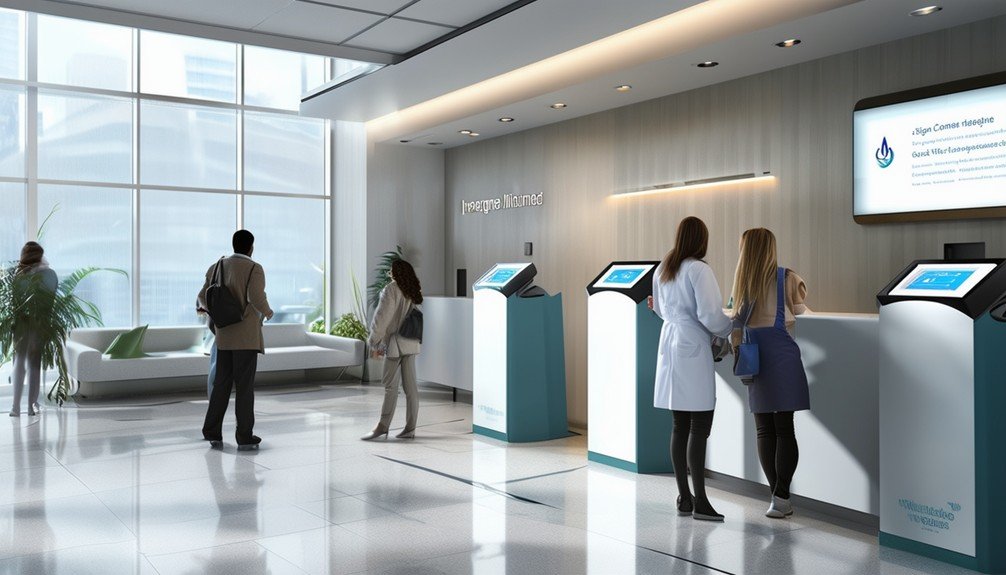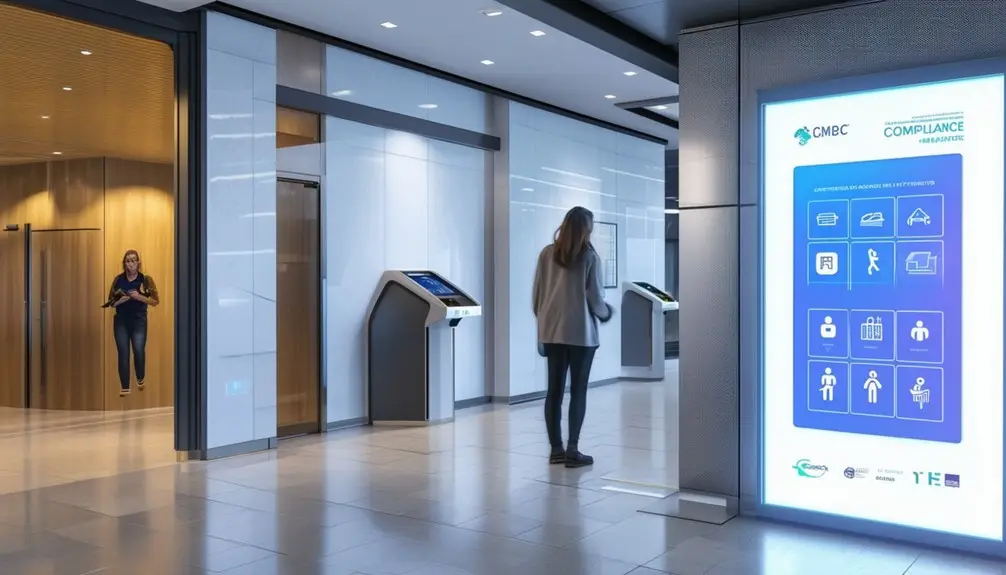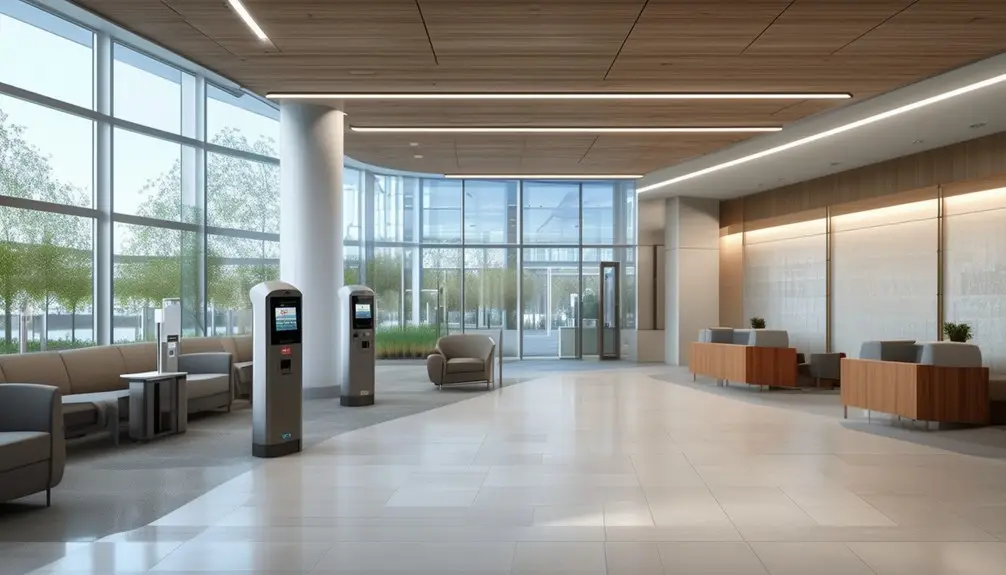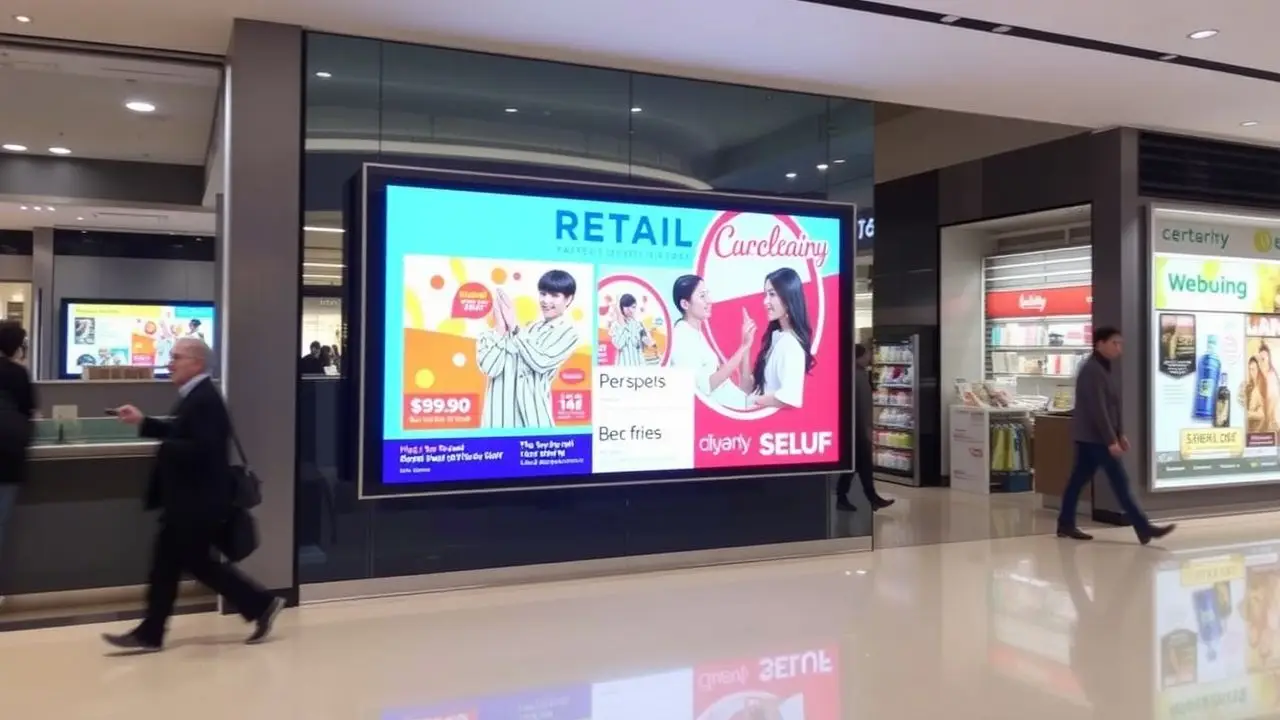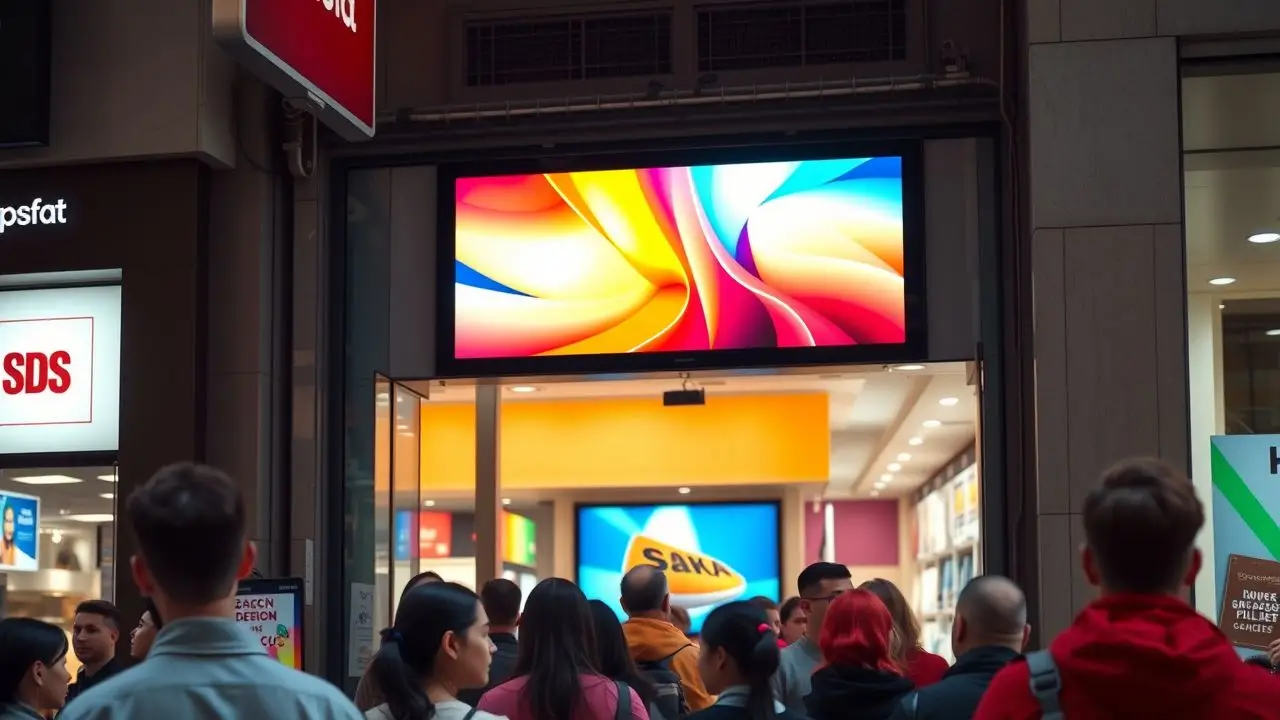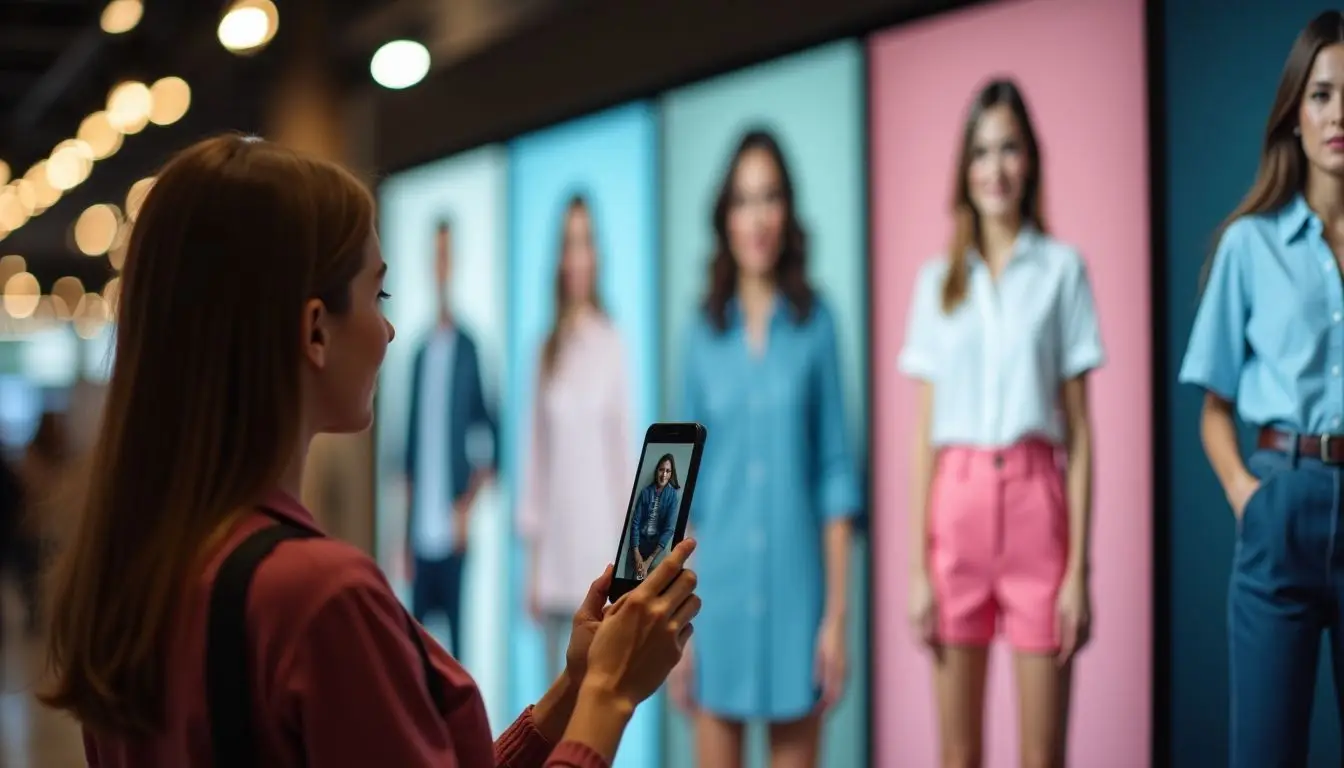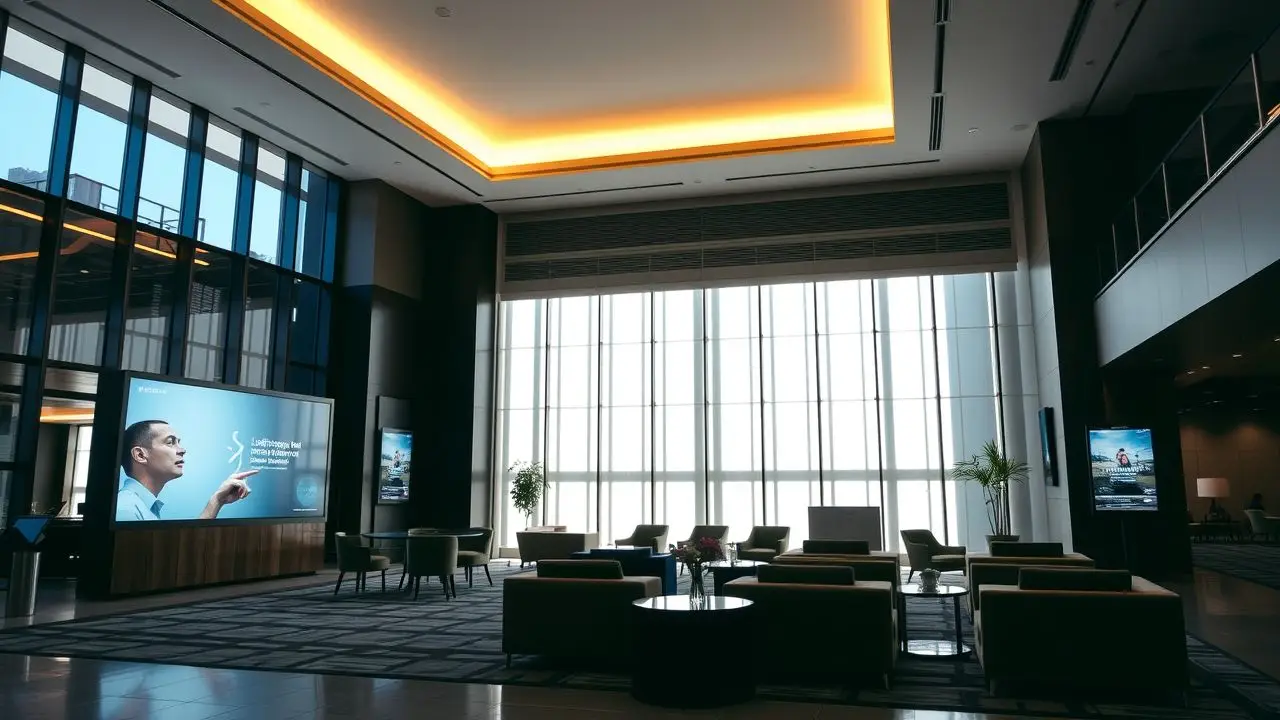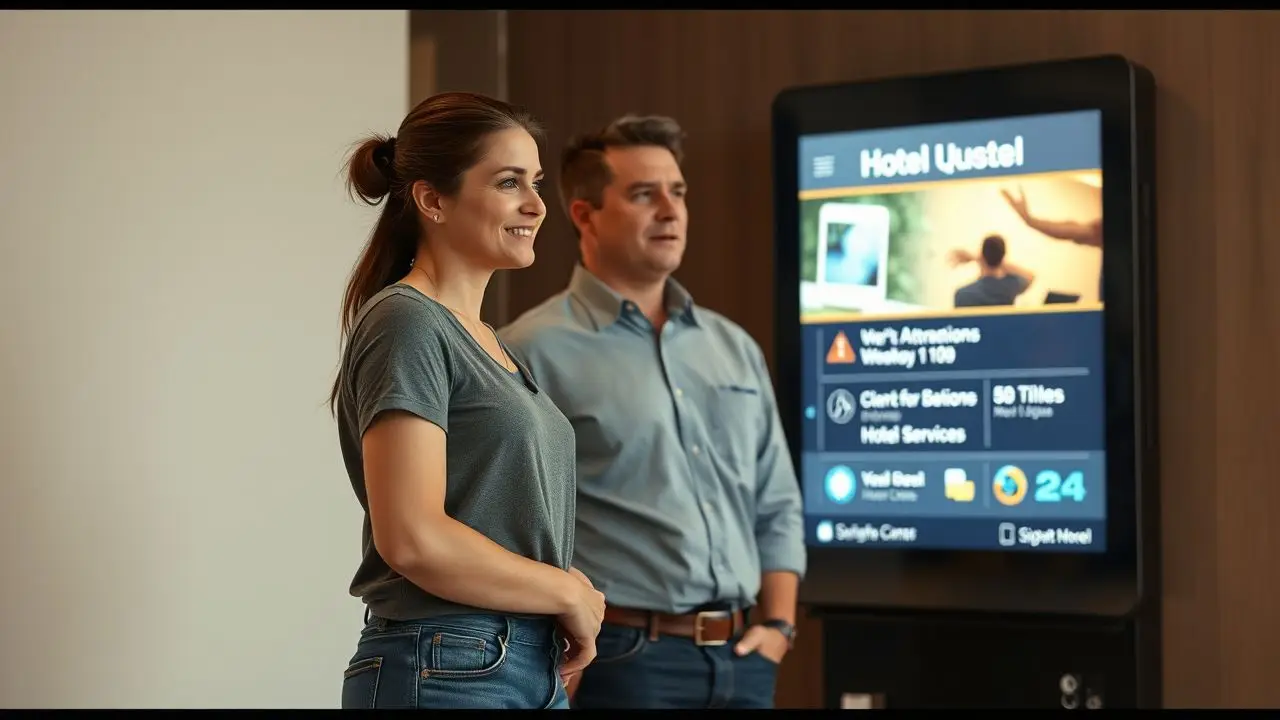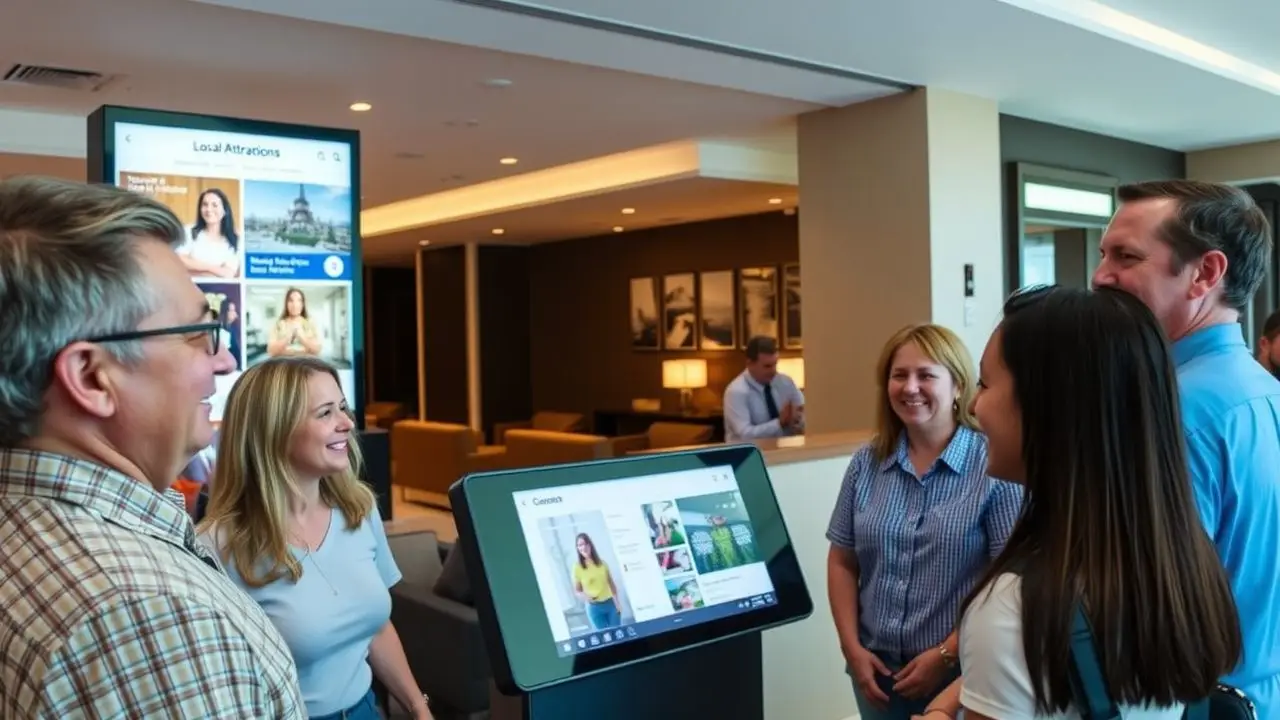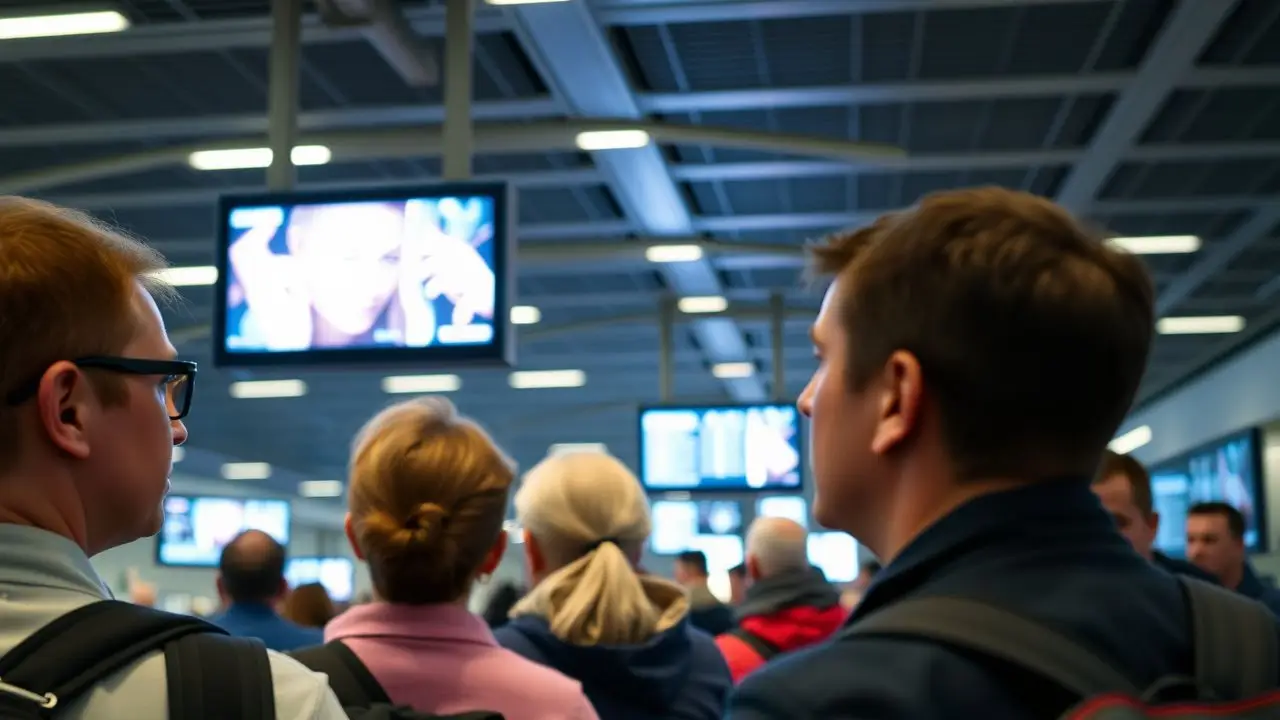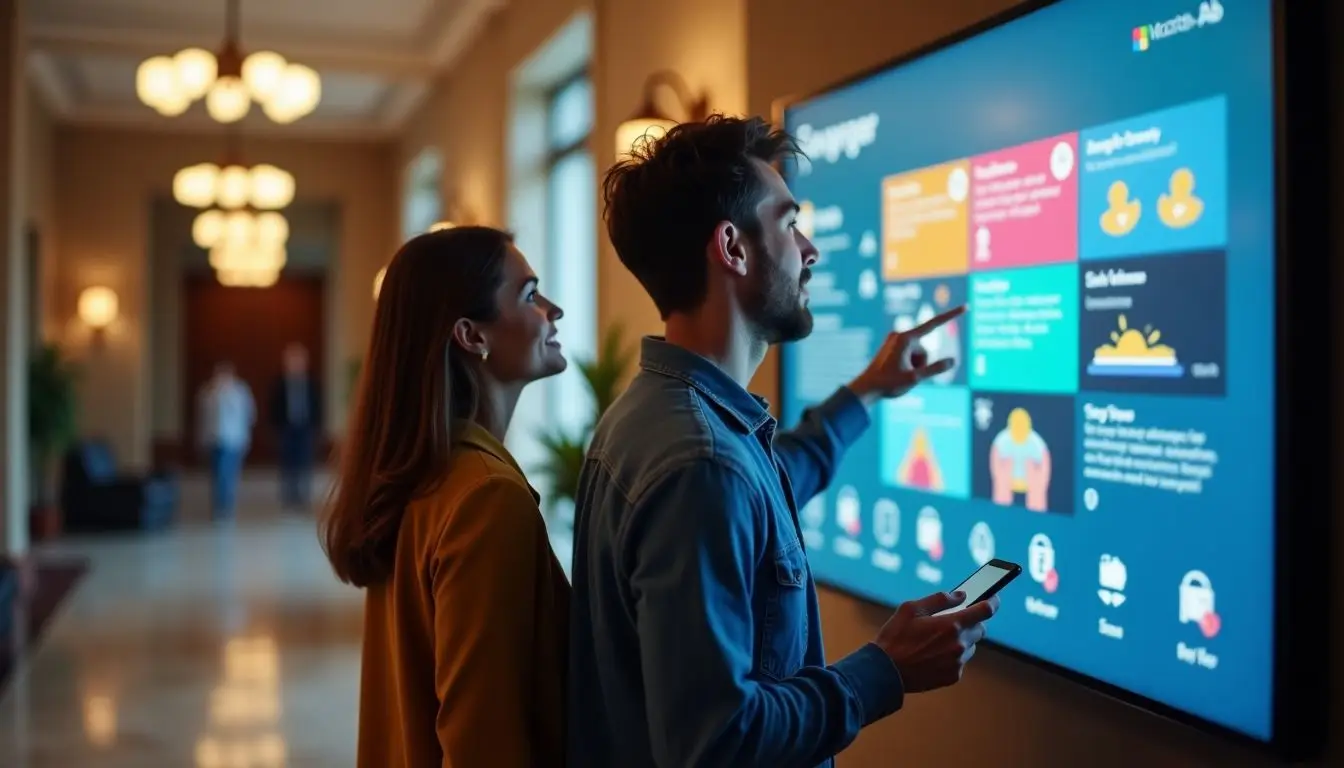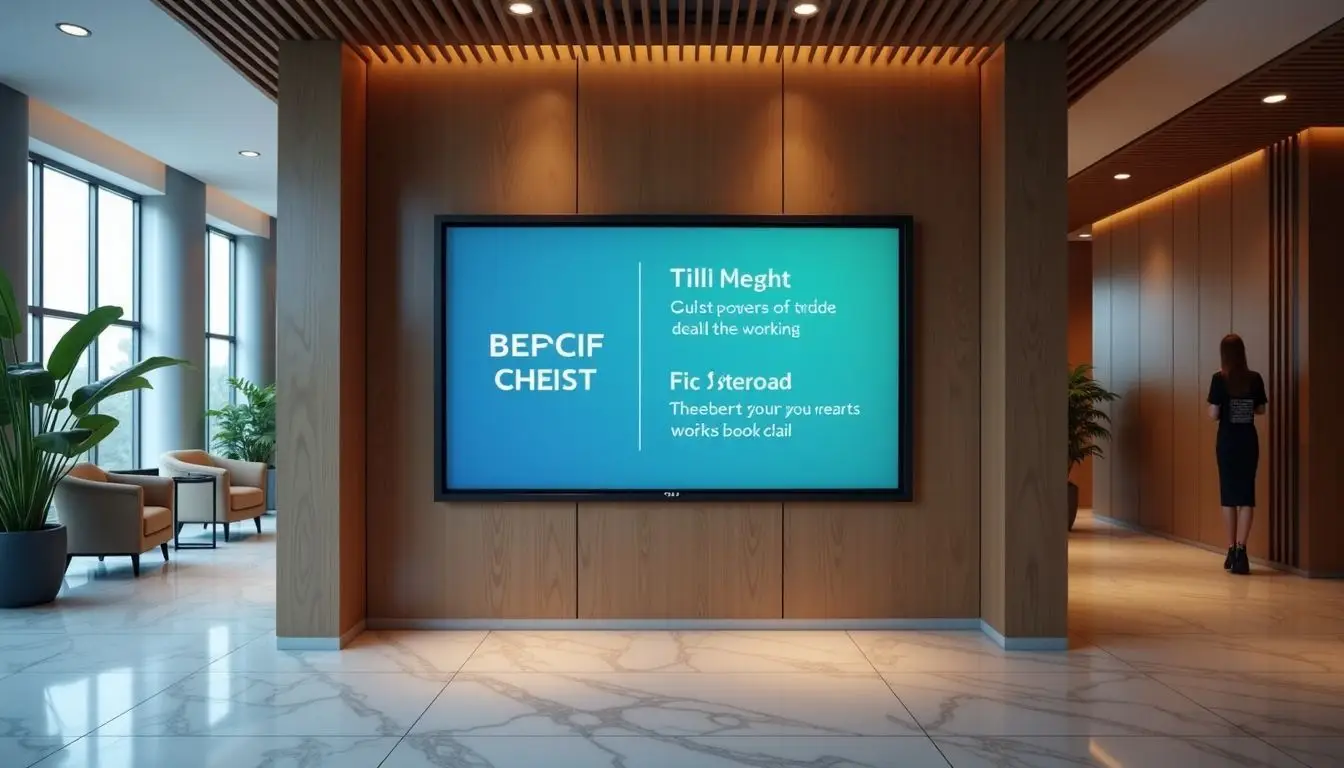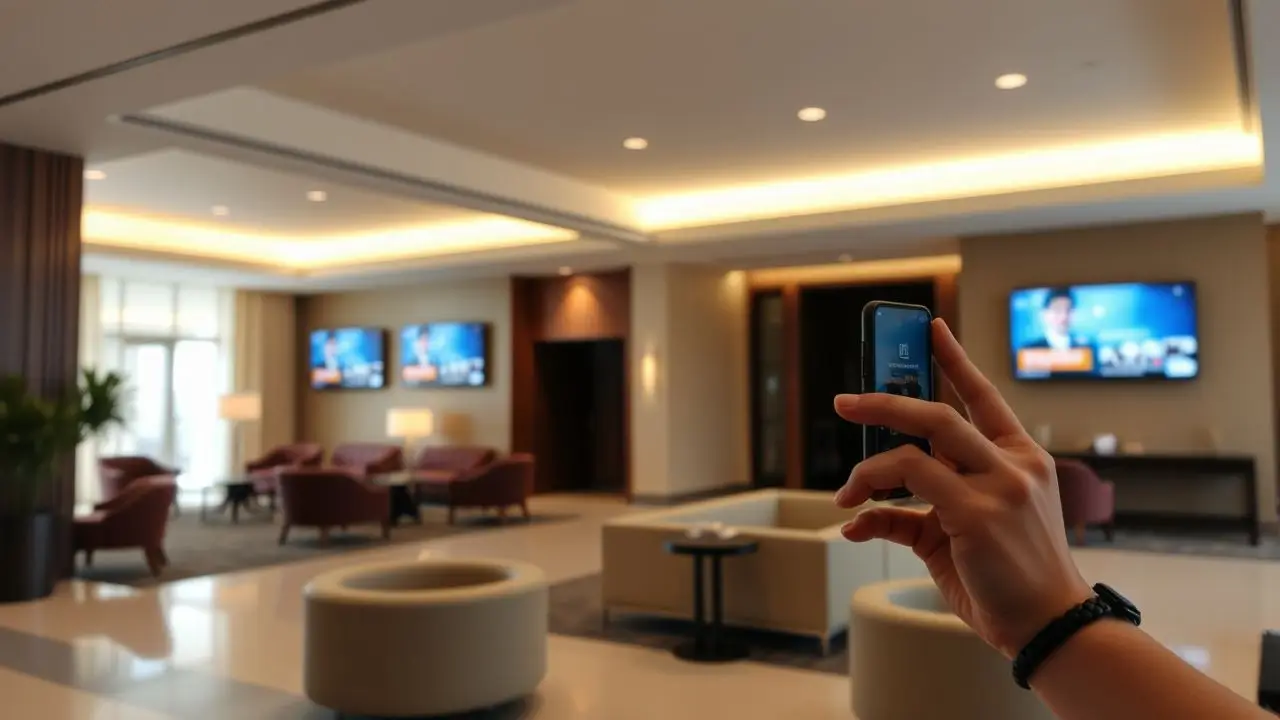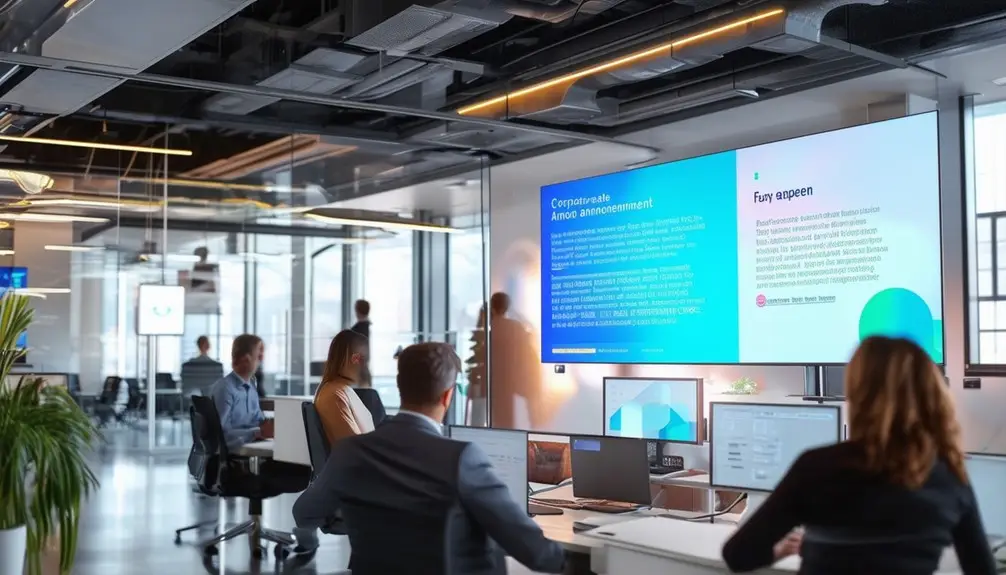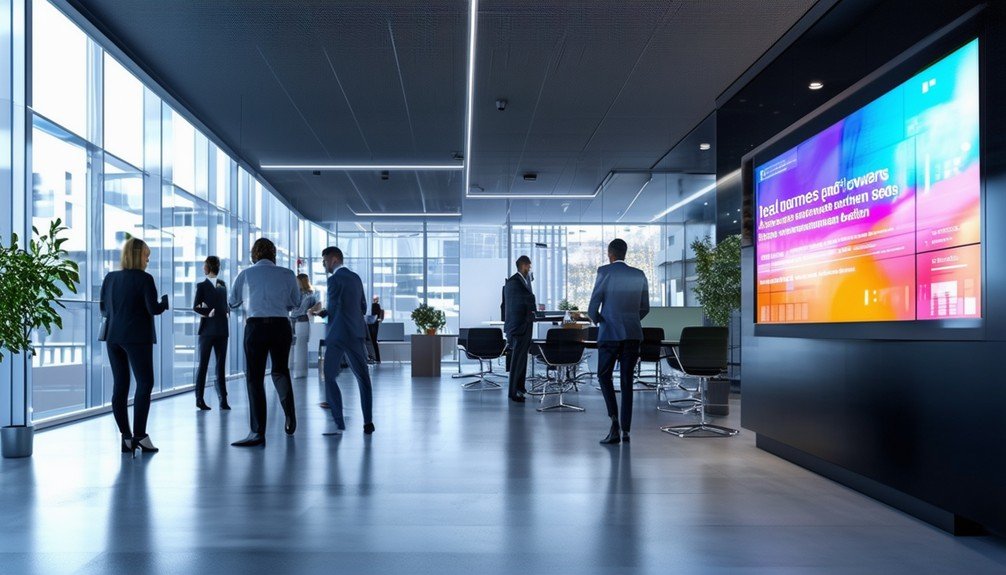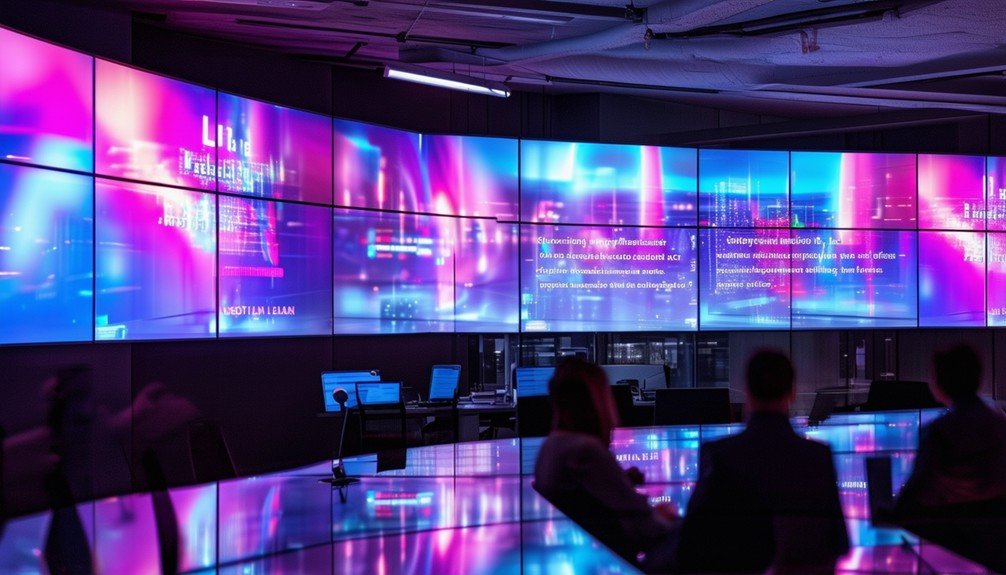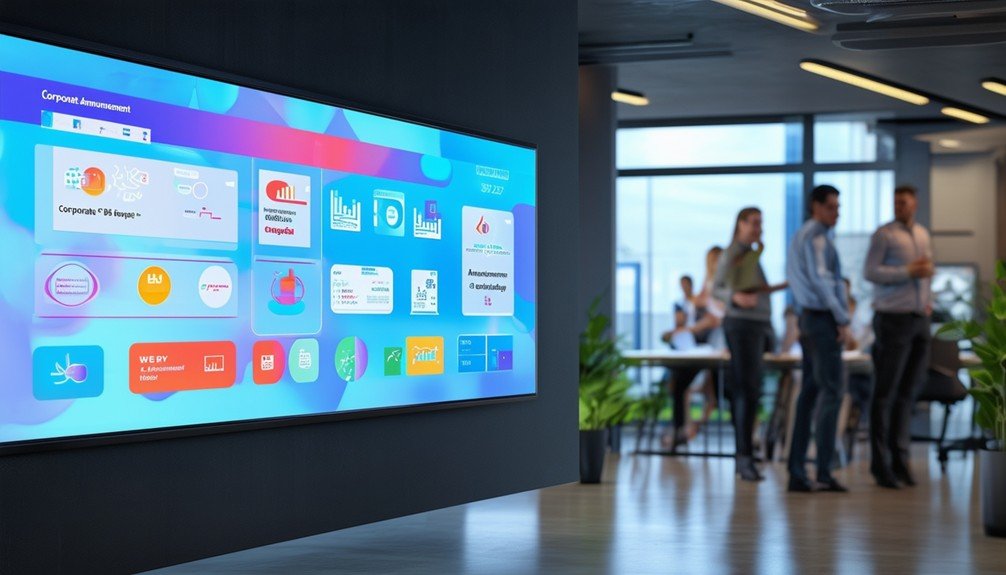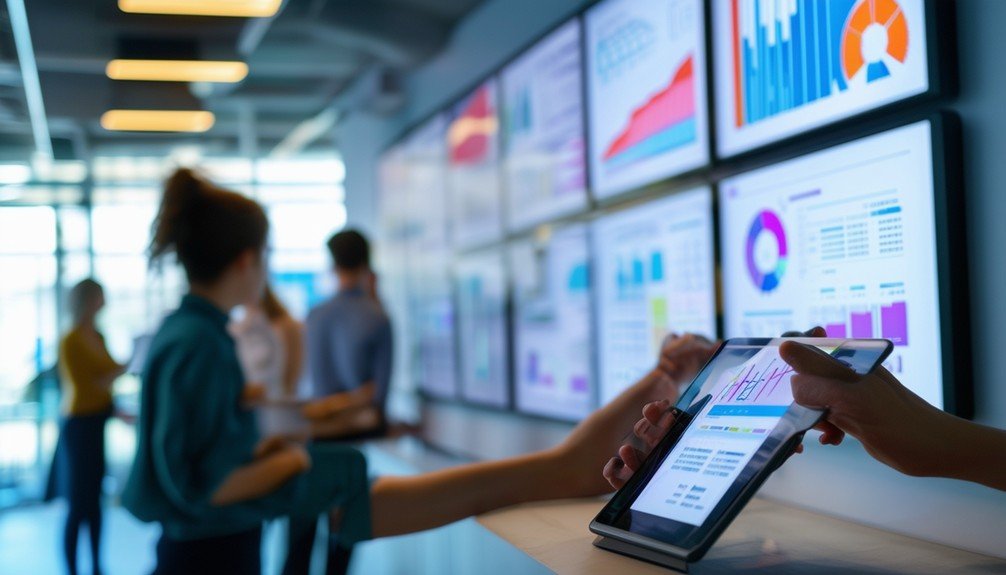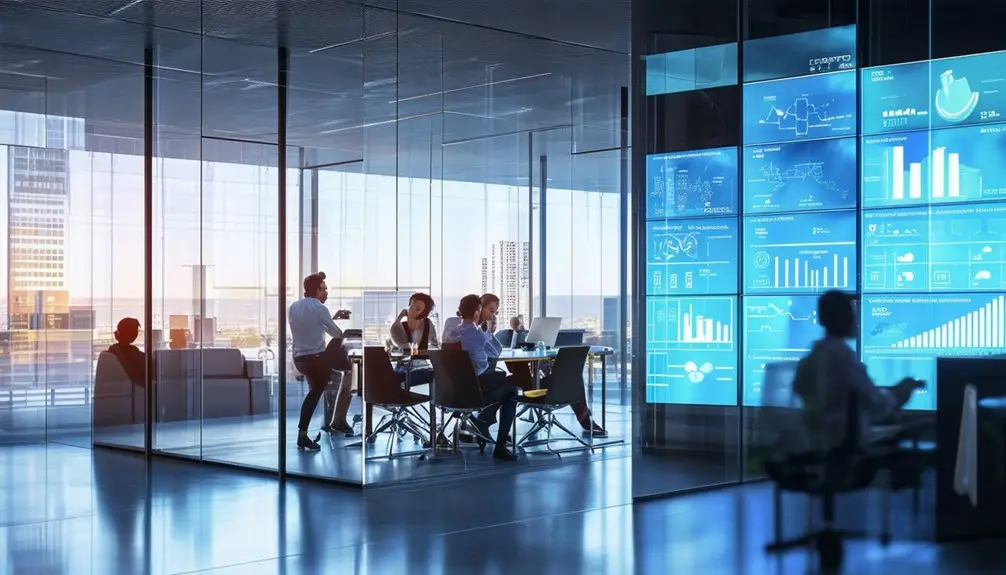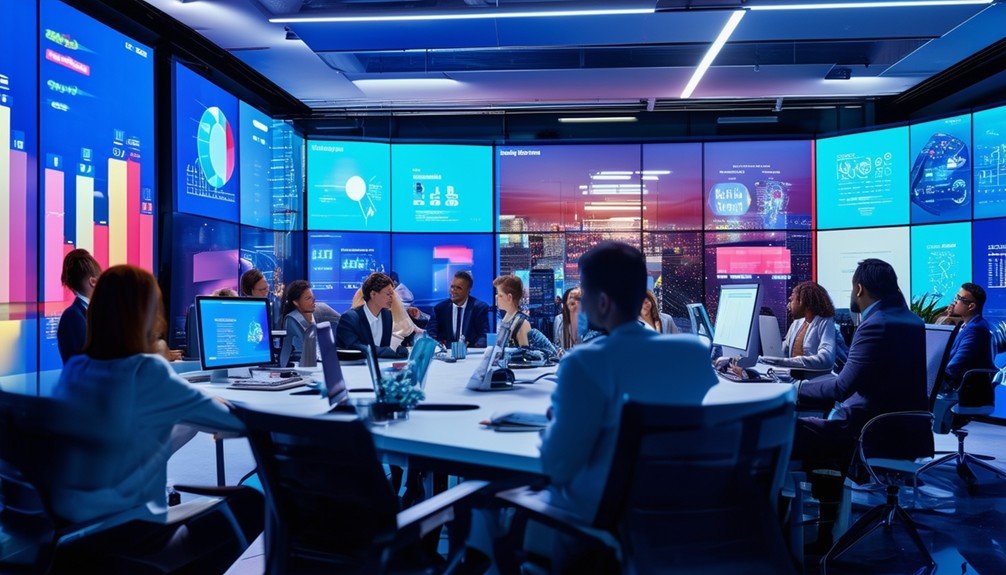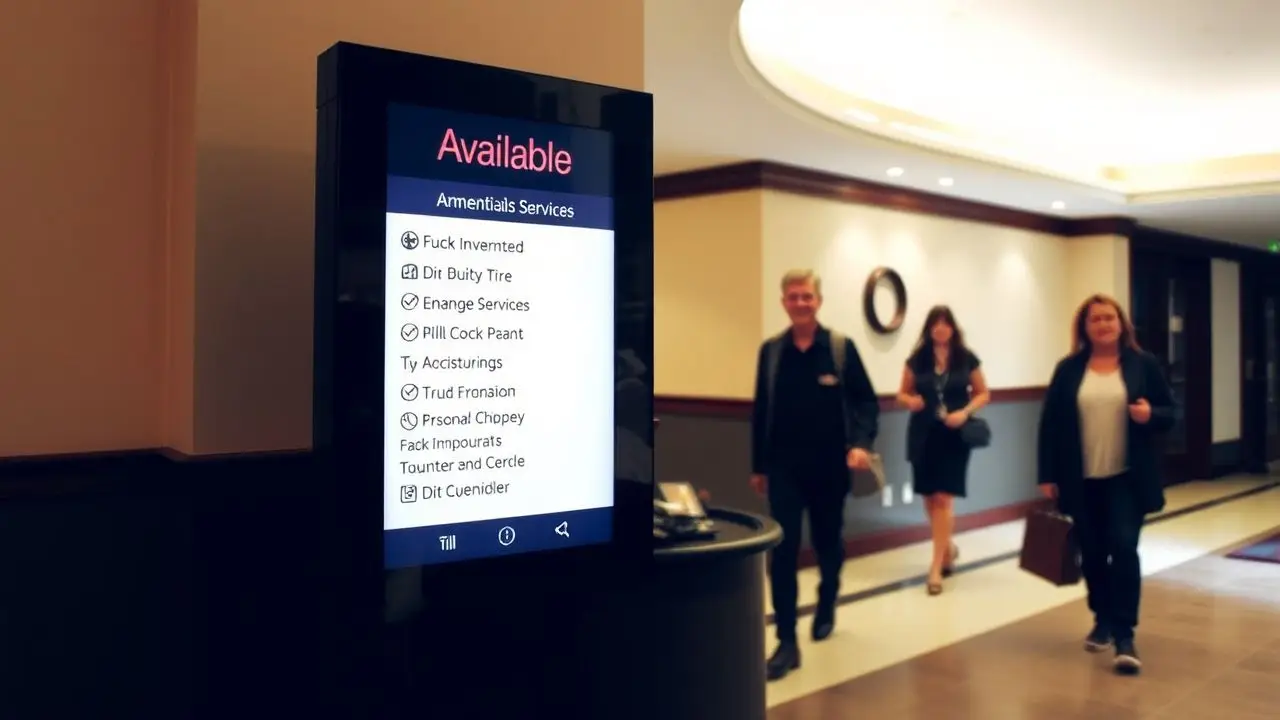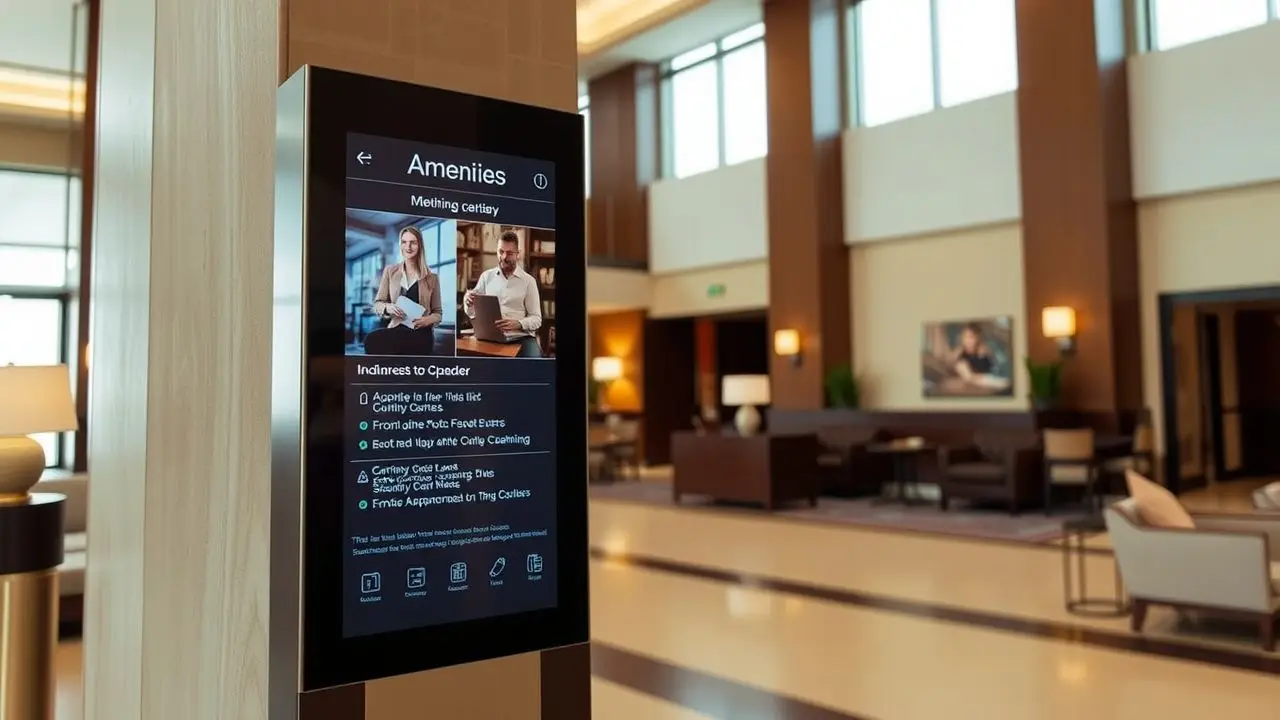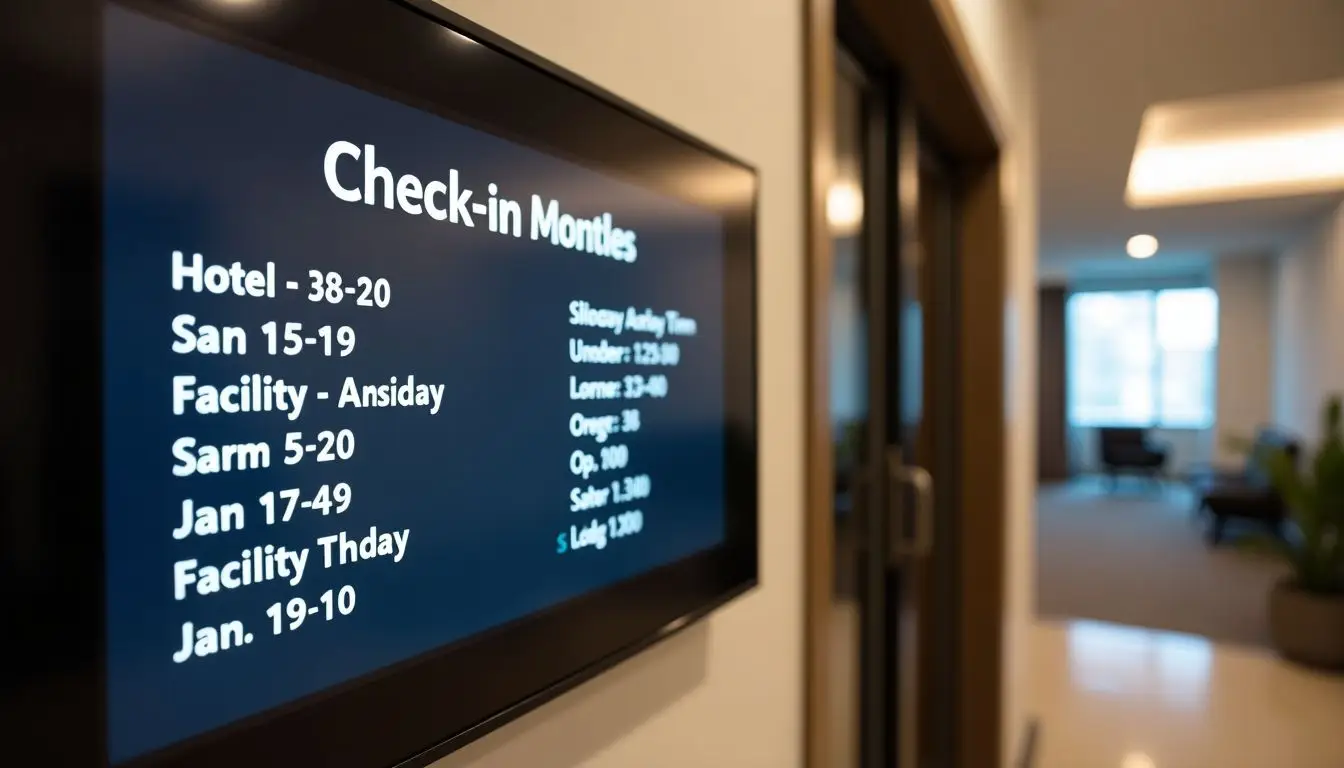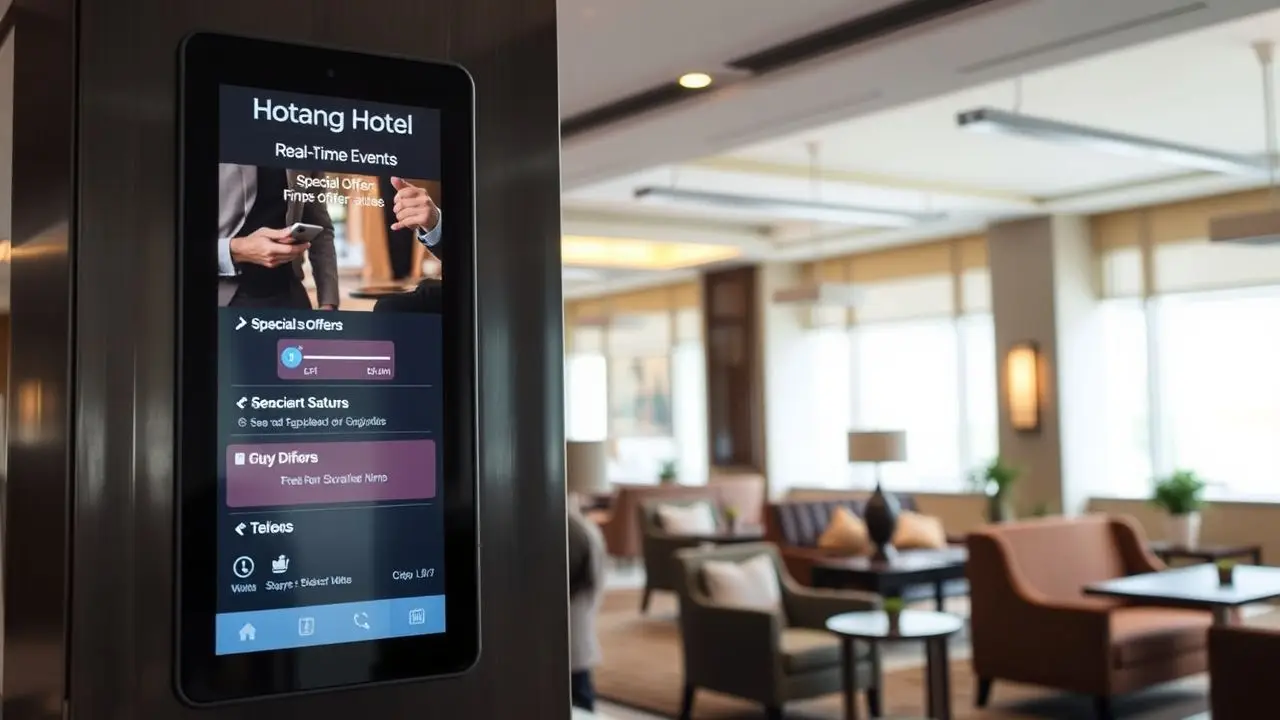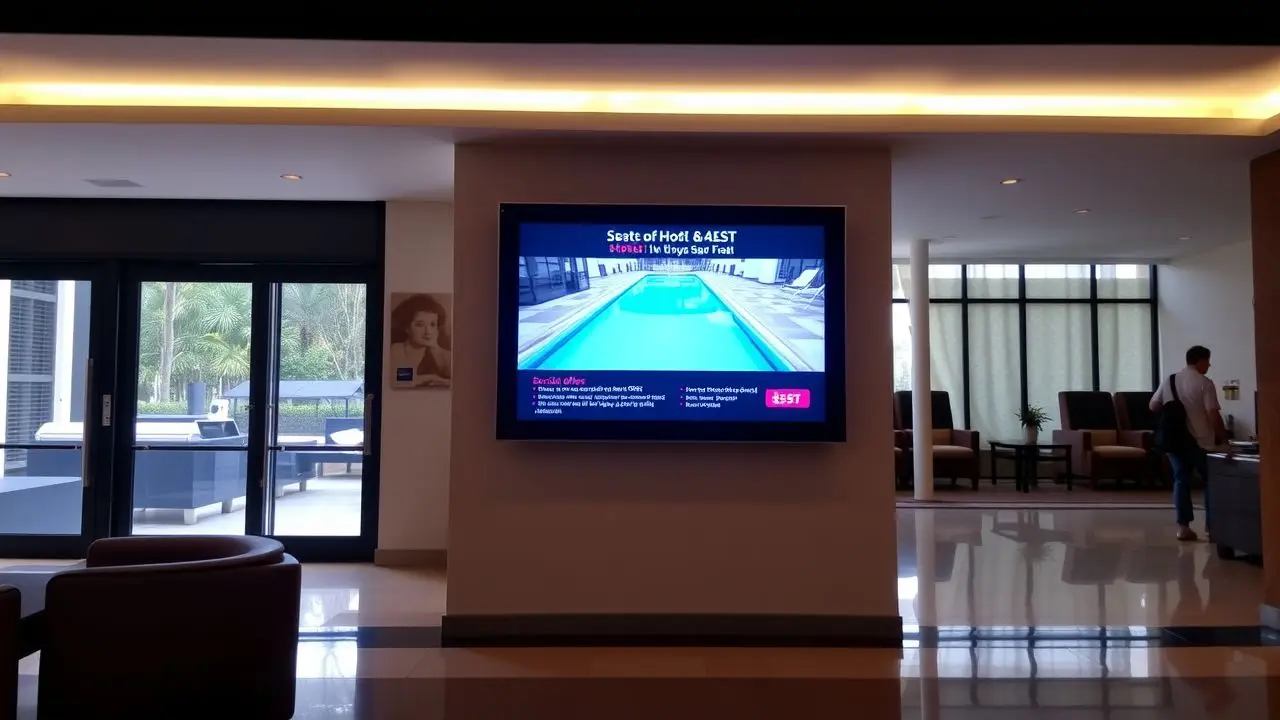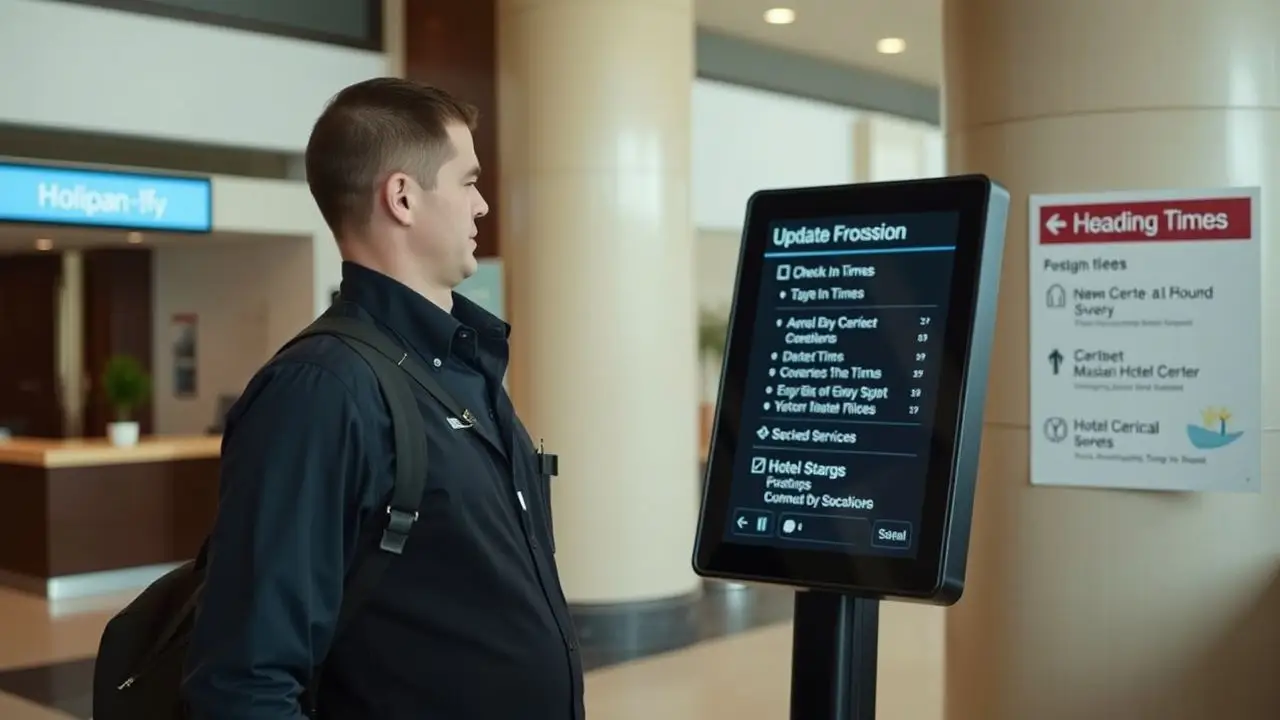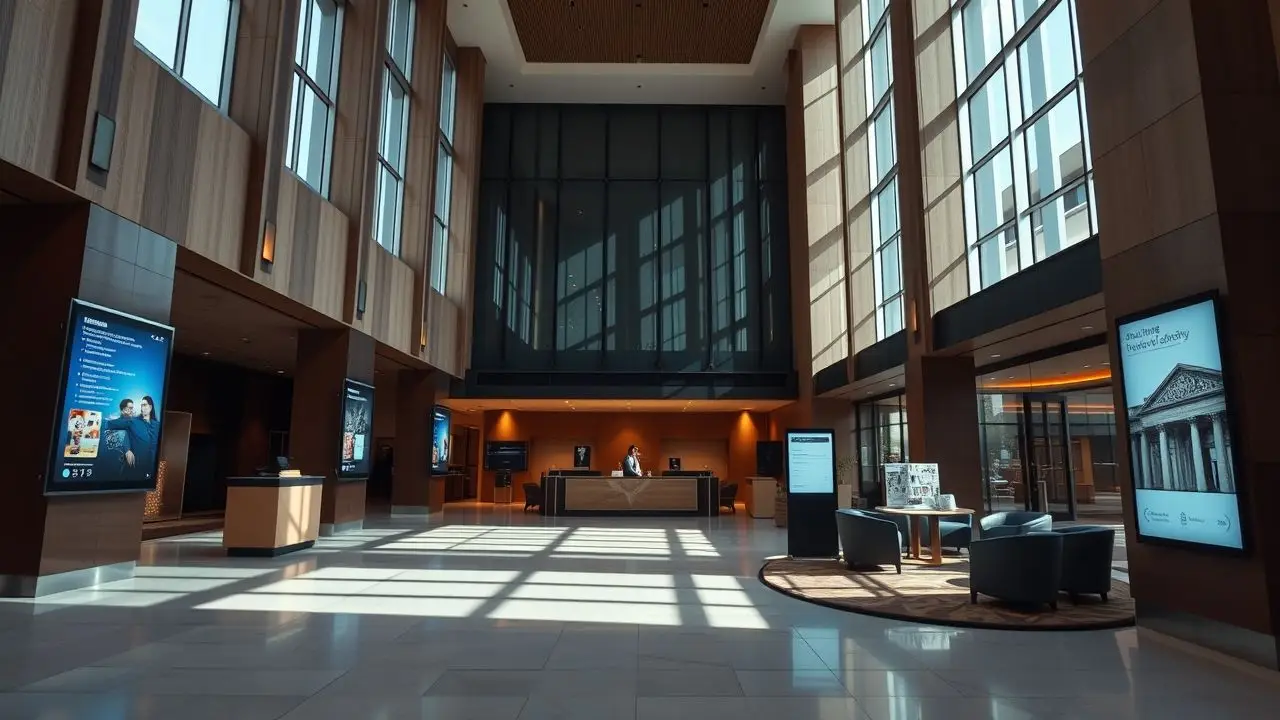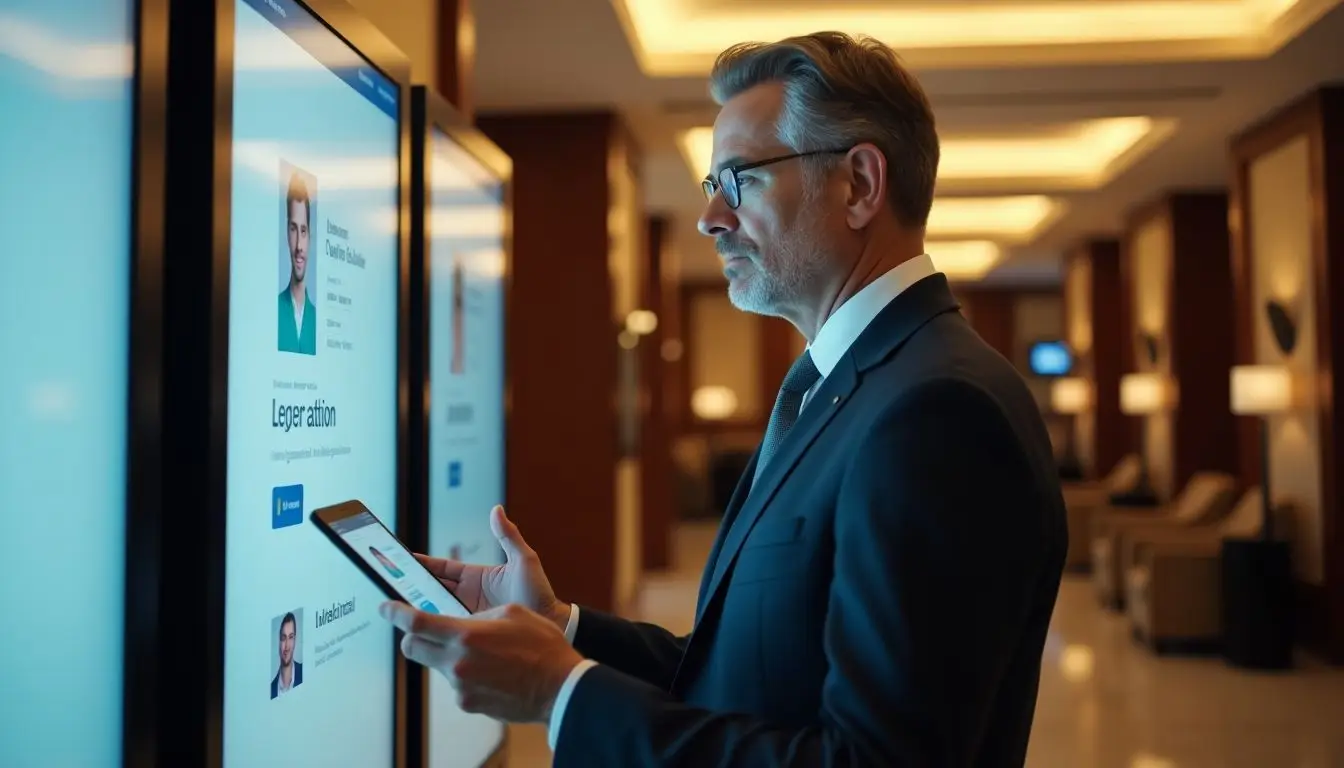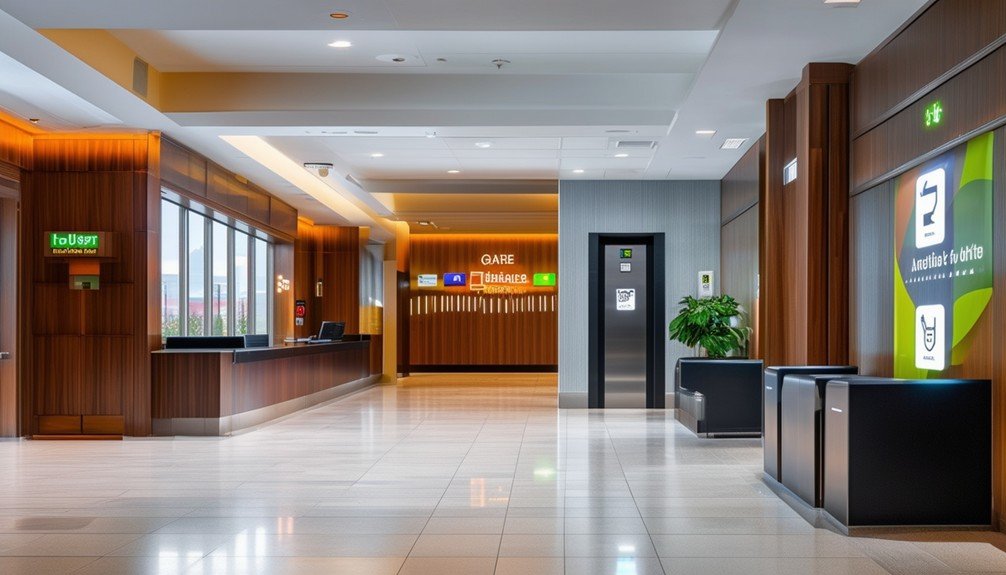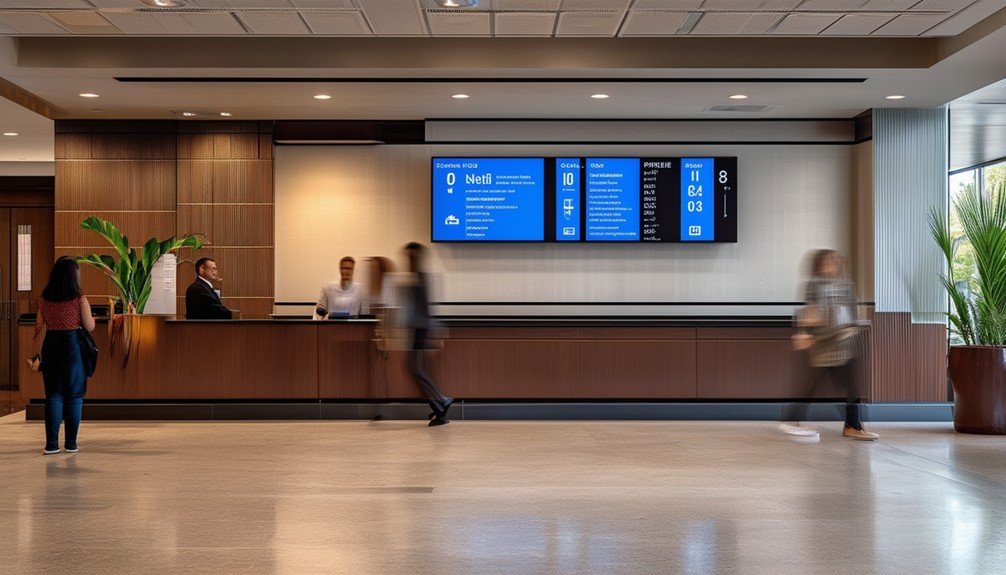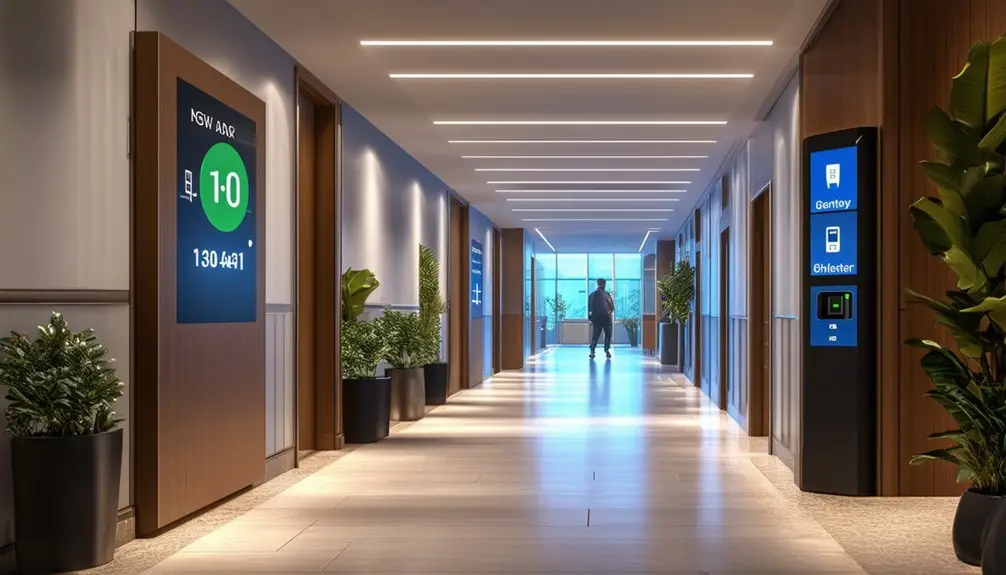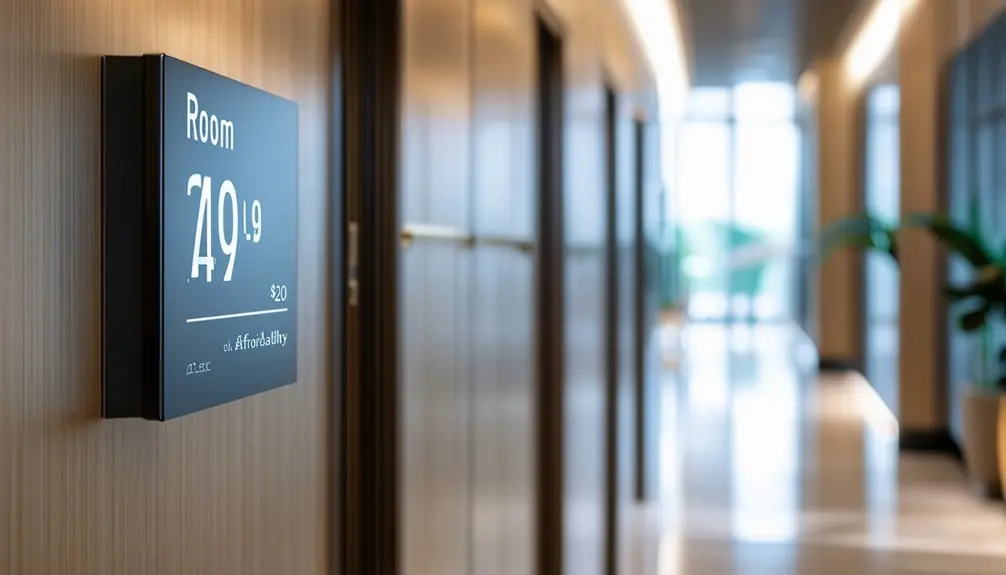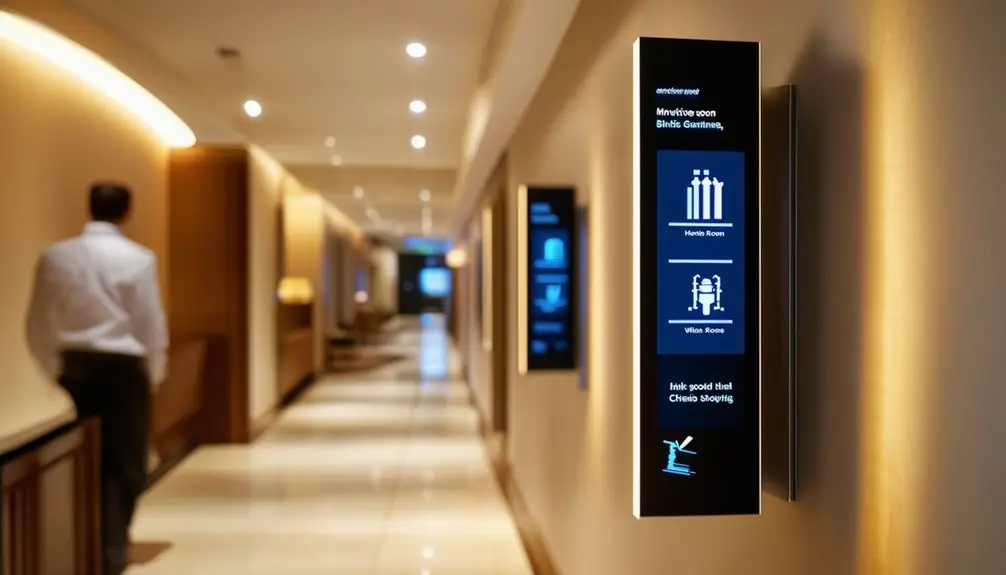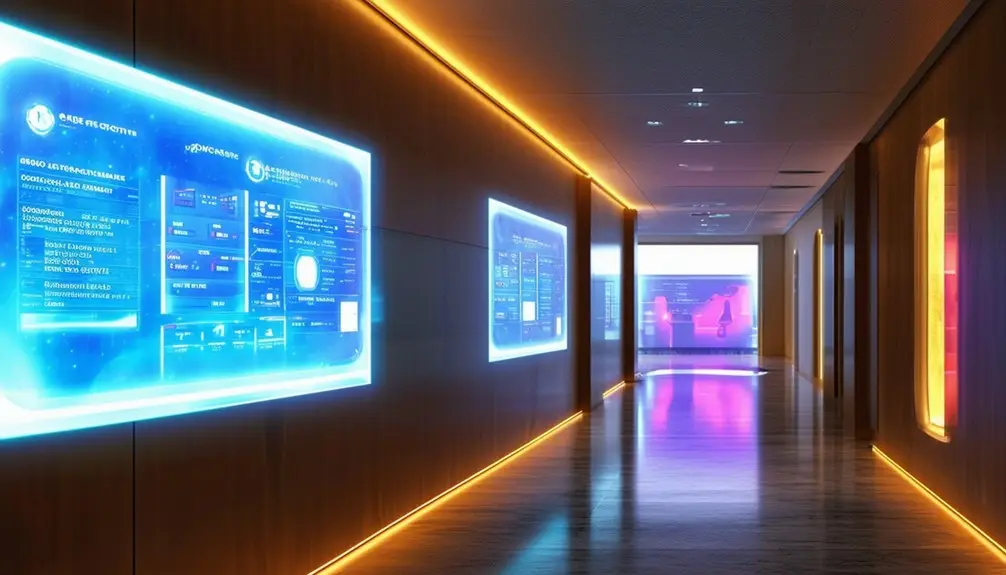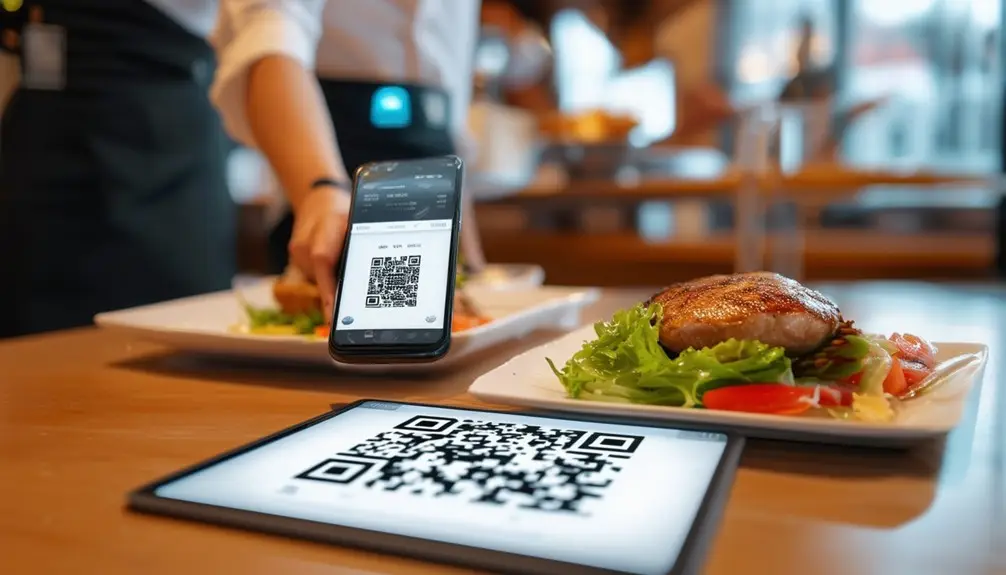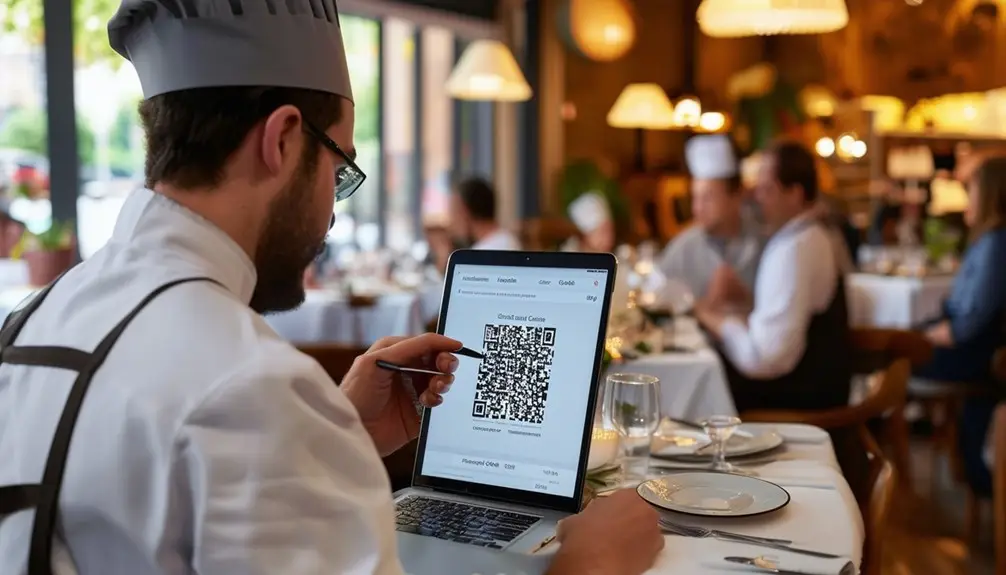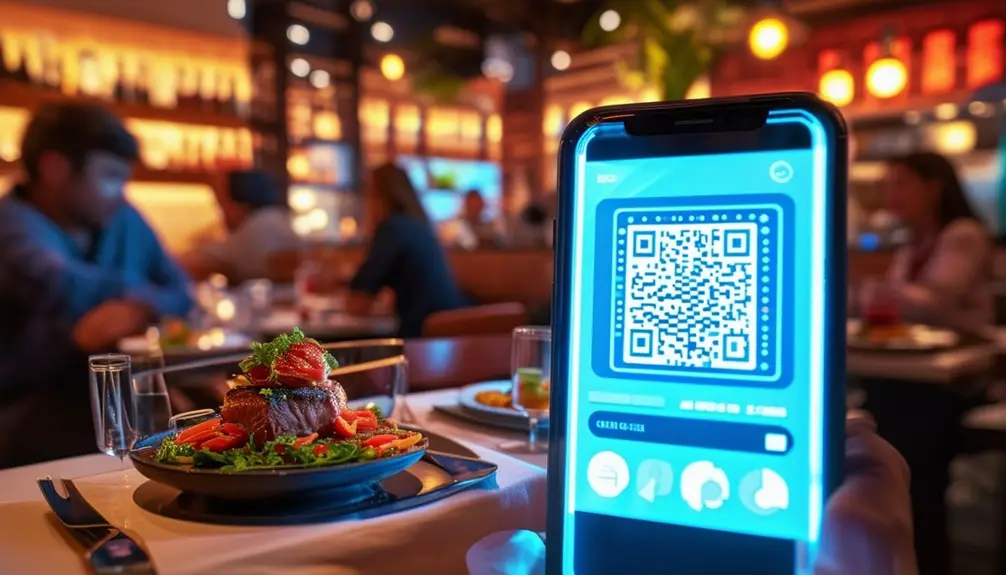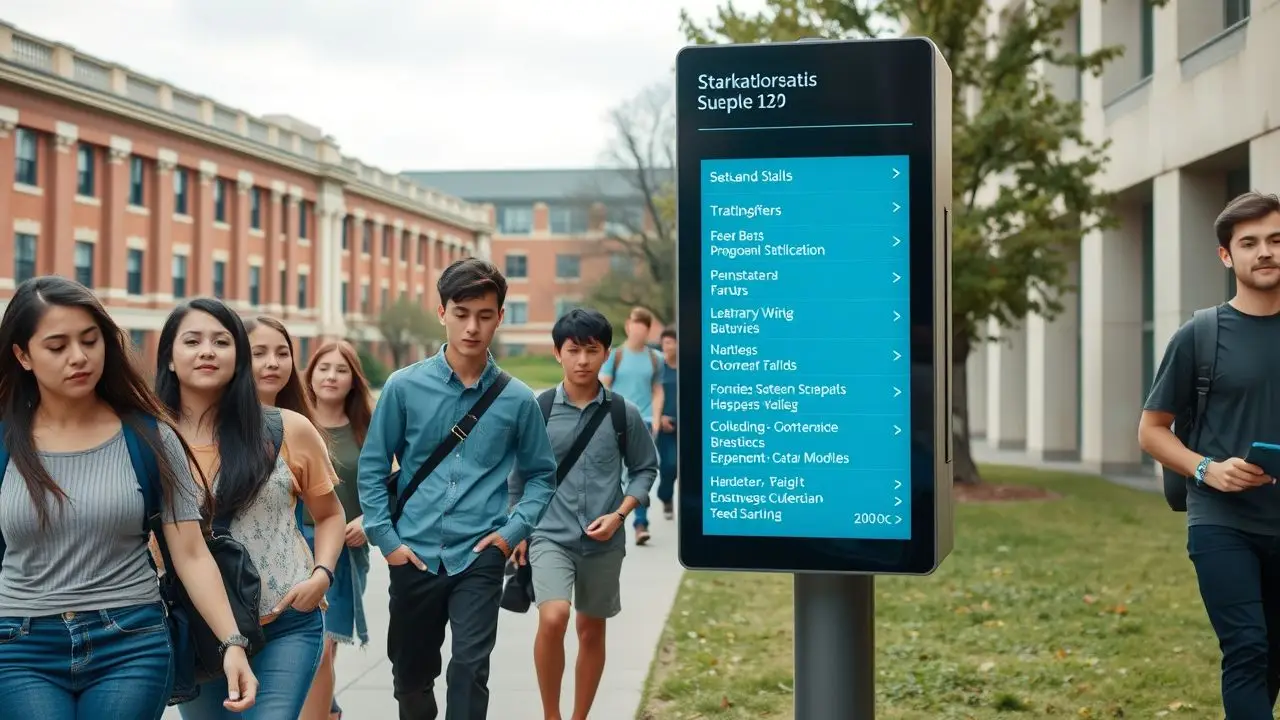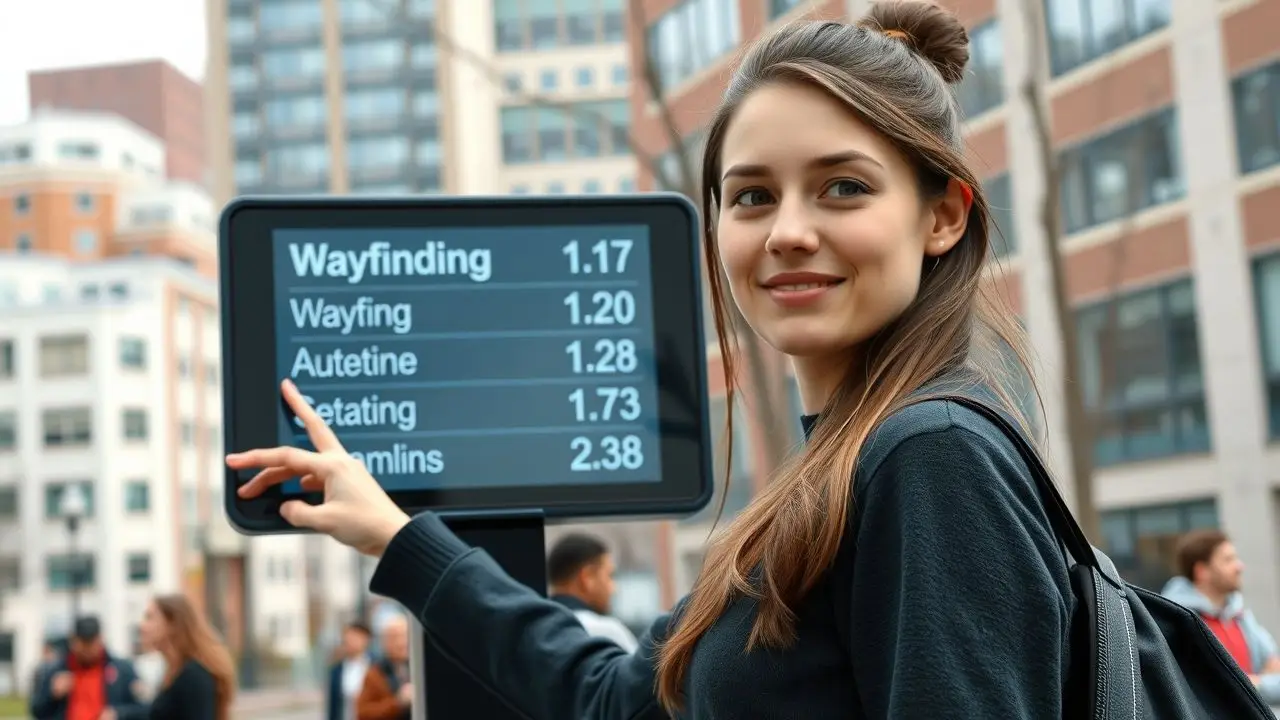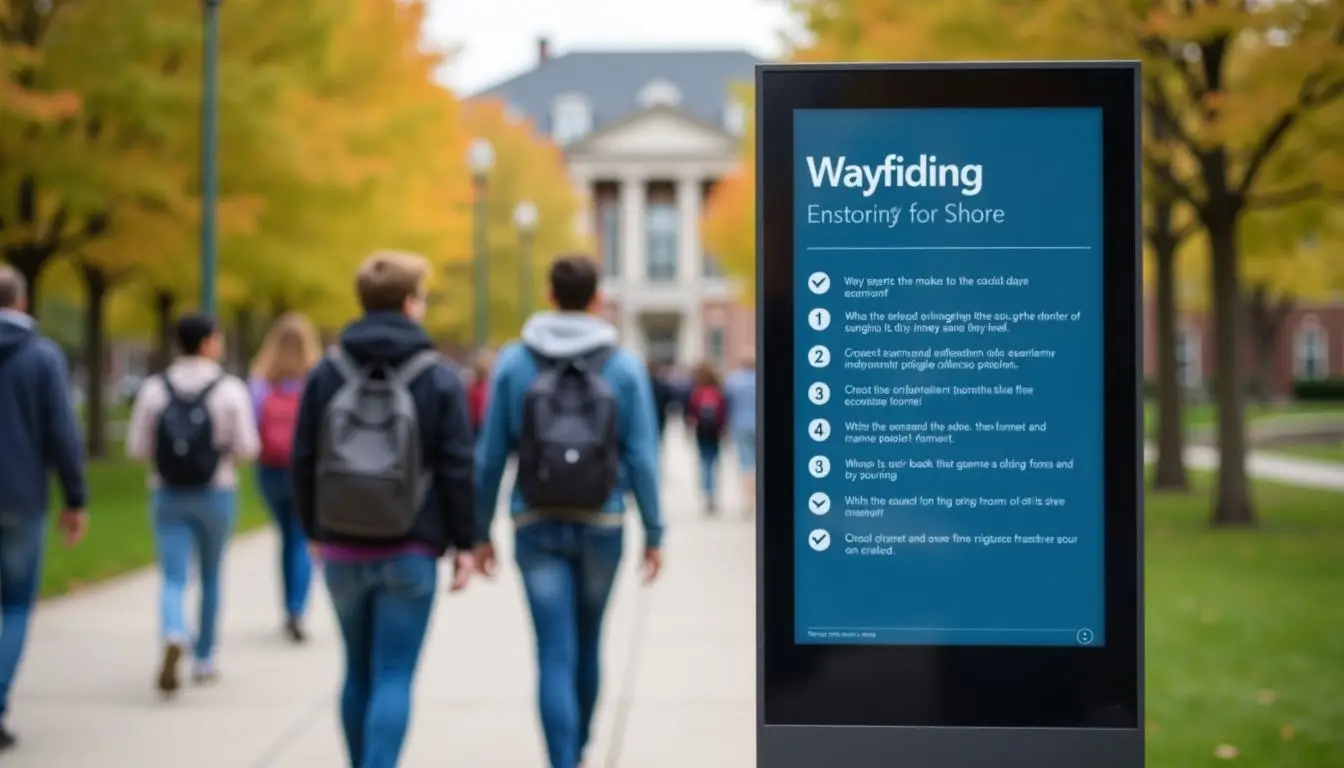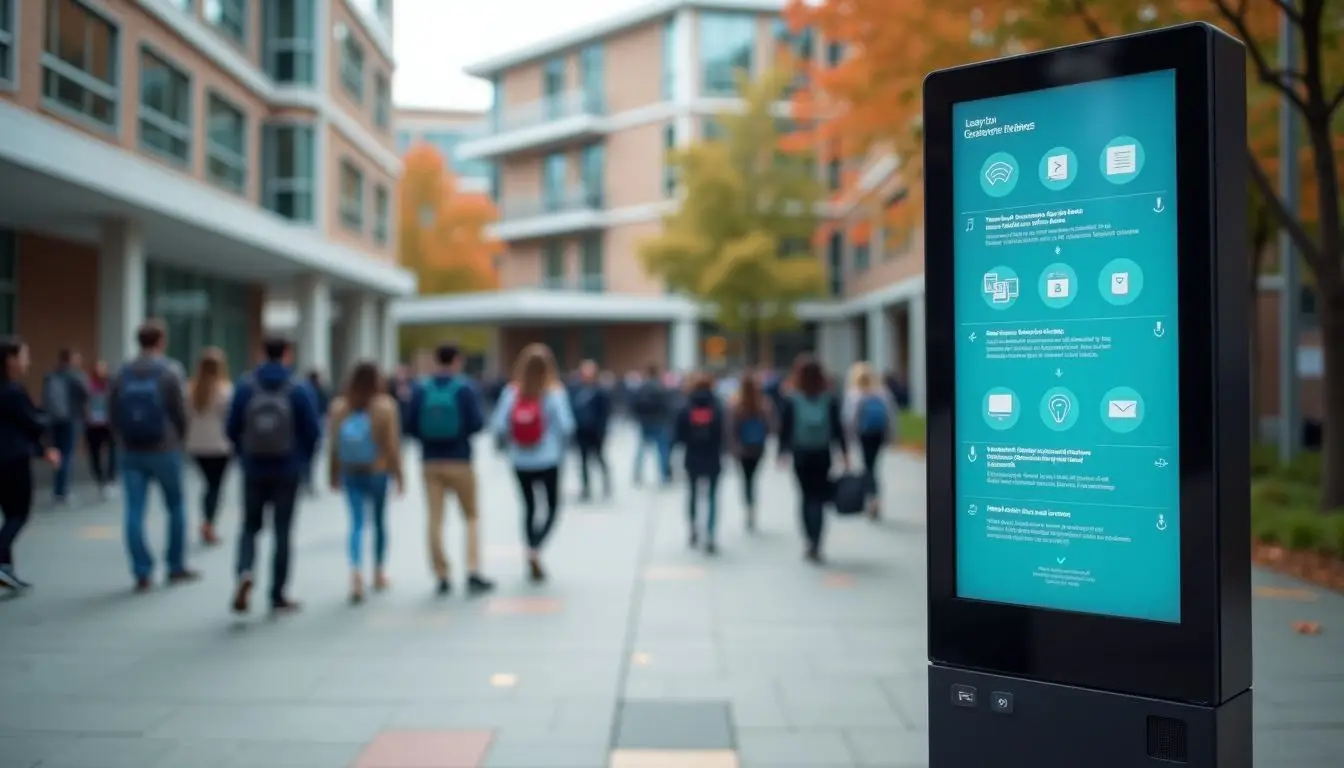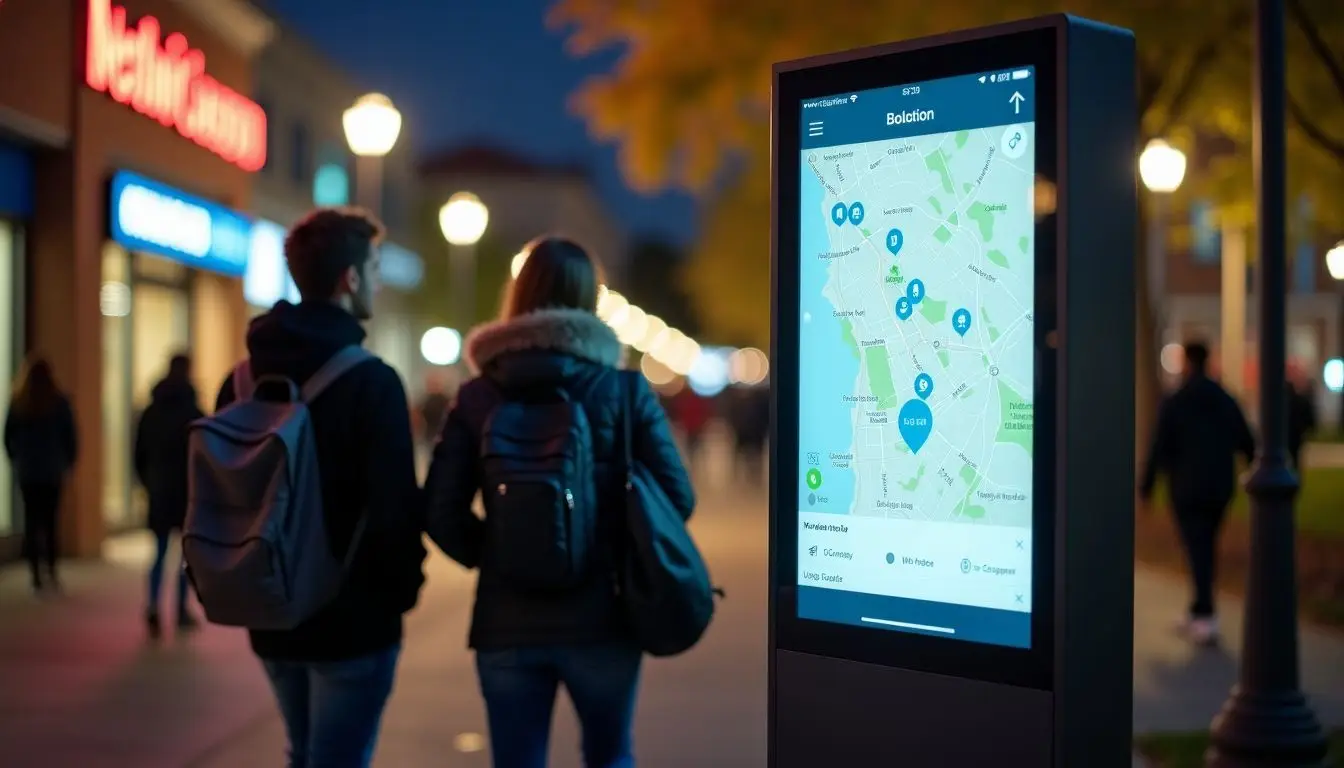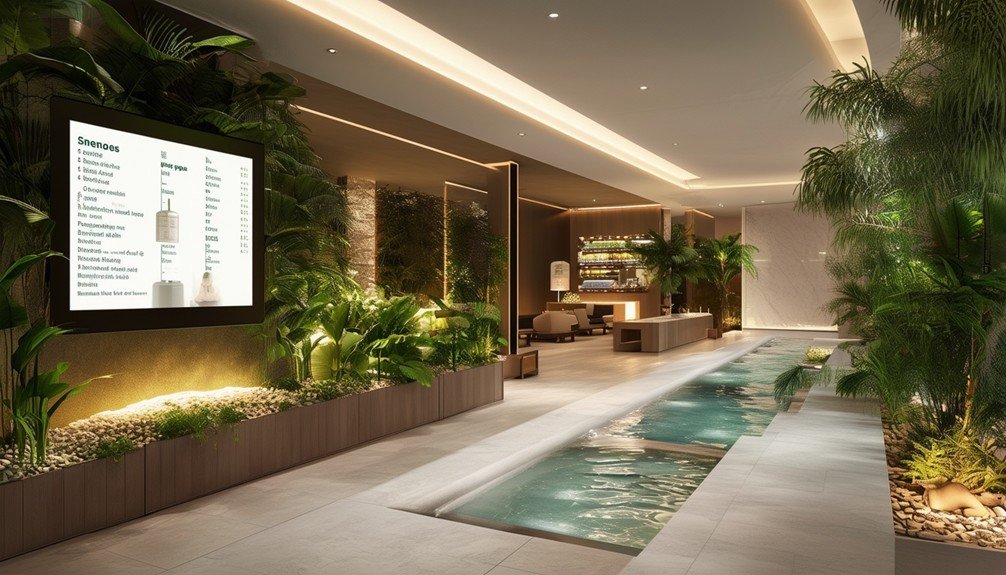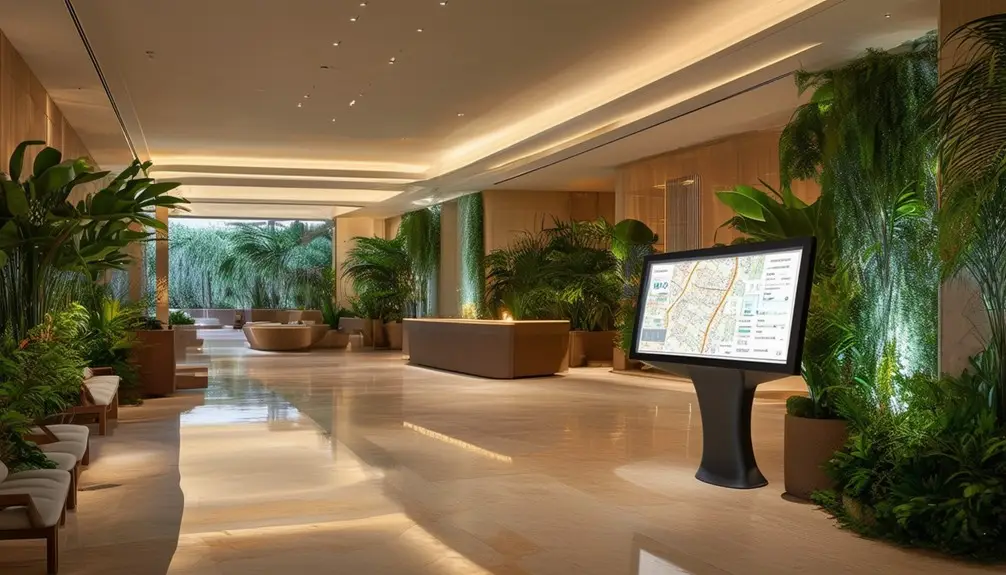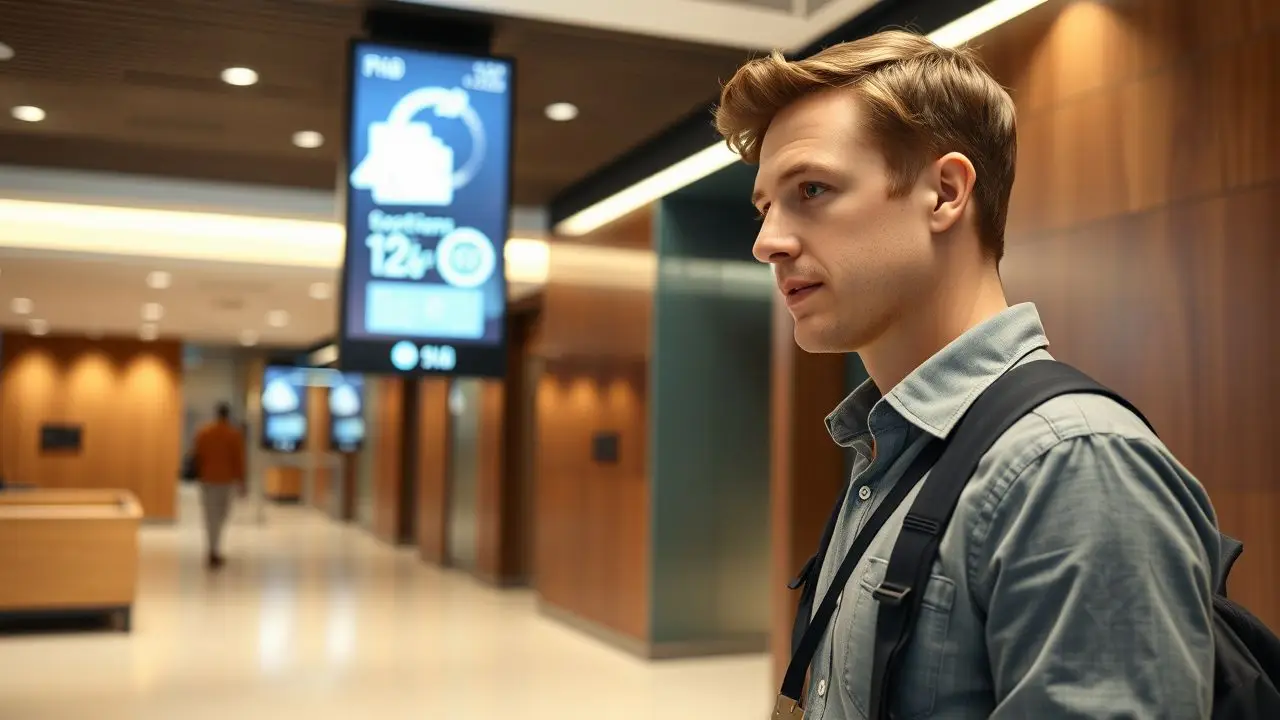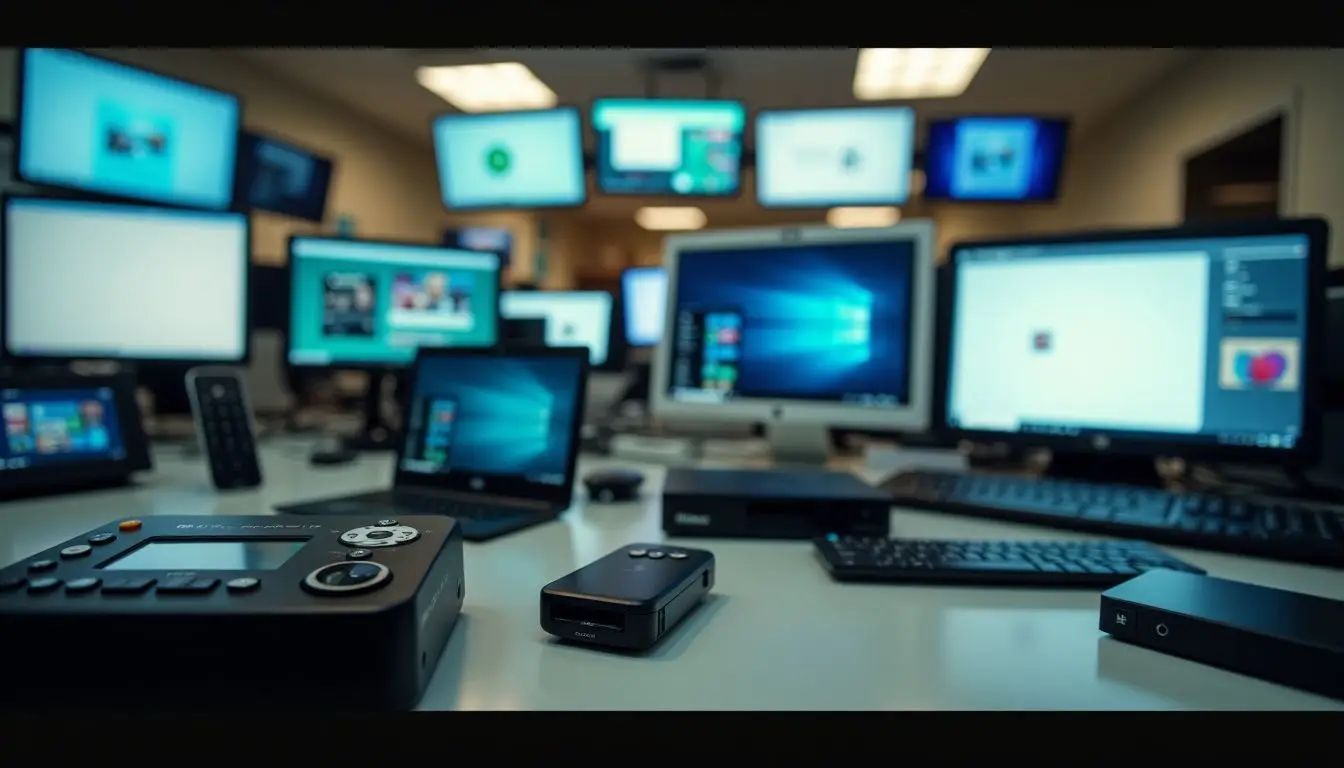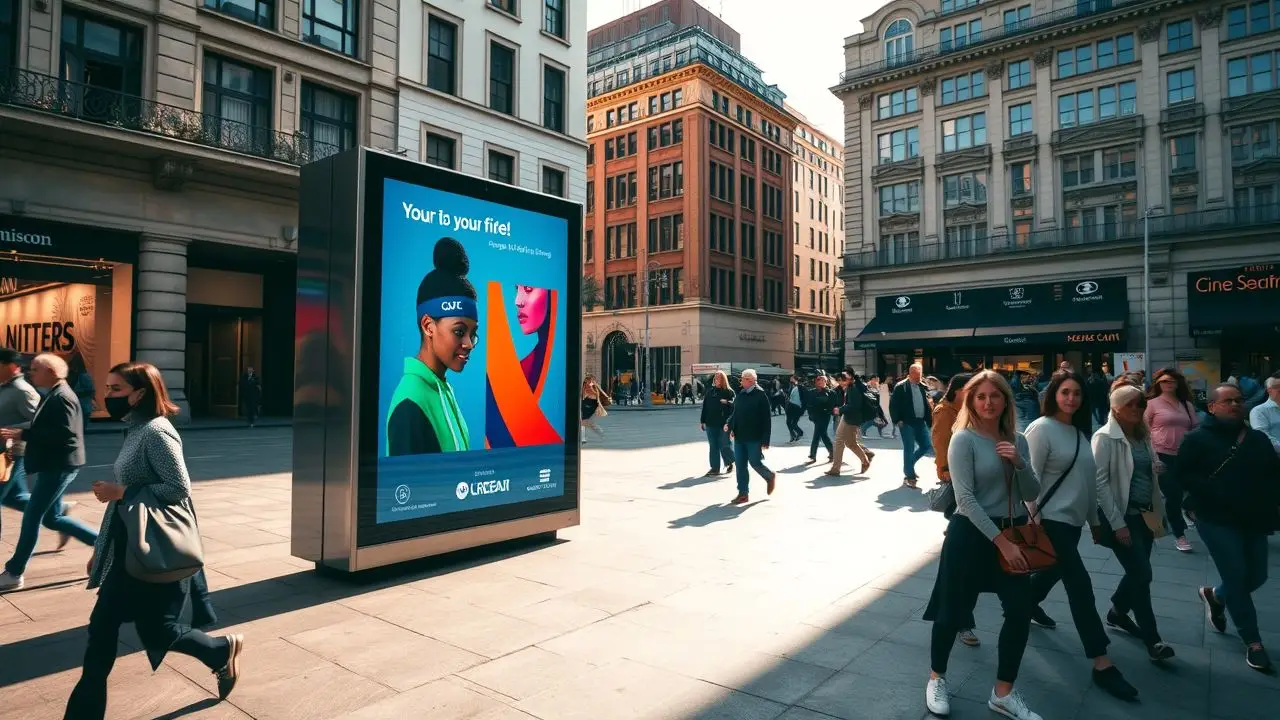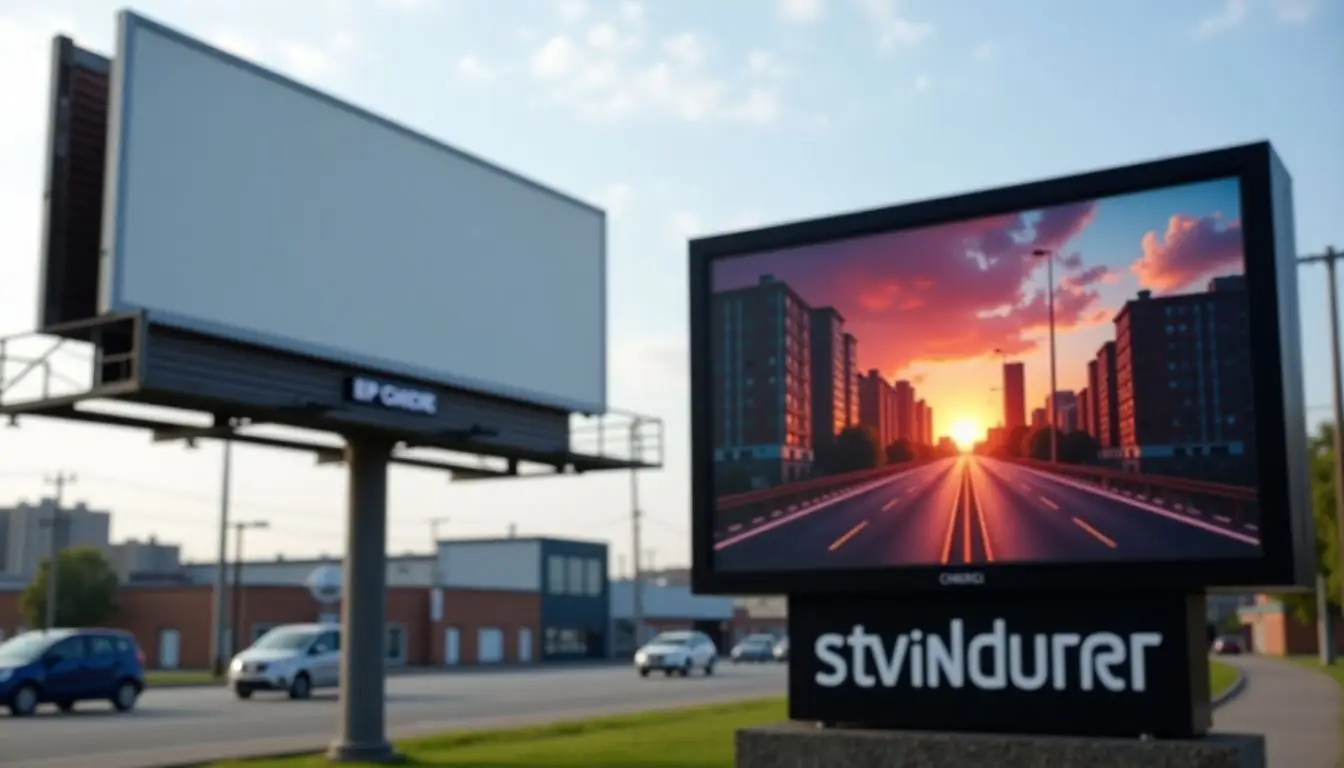Implementing effective hotel room signage systems boosts guest satisfaction and operational efficiency. You'll benefit from clear directional signage and interactive touchscreens, reducing guest confusion and enhancing navigation. Modern features like real-time updates and personalized messages aid in delivering tailored experiences while empowering guests with self-service options. Customizable solutions guarantee integration with your property management system (PMS) for seamless operation. When selecting a vendor, prioritize those with proven hospitality experience and robust content management systems. Budgeting should include installation, maintenance, and software licensing costs. Future trends, including AI and IoT integration, promise even smarter signage solutions enabling a superior guest experience.
Key Takeaways
- Real-time updates ensure that room signage displays the most current information for guests.
- Interactive touch screens offer easy navigation and multi-language support for a stress-free experience.
- Seamless data synchronization automatically updates room statuses and guest preferences.
- Customizable signage solutions allow personalized messaging and content tailored to individual guest preferences.
- AI and IoT integration enhance the responsiveness and intelligence of room signage systems.
Importance of Hotel Signage
In today's competitive hospitality industry, hotel signage is crucial for guiding guests efficiently to their rooms and facilities, ultimately enhancing their overall experience. When you implement effective hotel signage, you provide clear directions that greatly reduce guest confusion and streamline their navigation. This clarity is essential for ensuring a positive guest experience, as it allows them to access hotel amenities effortlessly.
Additionally, the use of digital signage can further elevate guest satisfaction by delivering up-to-date information and interactive guidance. By integrating digital elements, you not only modernize the guest experience but also enhance guest engagement. Guests are more likely to feel valued and informed, which directly contributes to higher satisfaction rates.
Hotel signage also plays a crucial role in reinforcing your brand identity. Consistent and well-designed signage that aligns with your hotel's aesthetics can leave a lasting impression on guests, further embedding your brand into their minds. This consistency helps build trust and loyalty, as guests appreciate the attention to detail and professionalism.
Lastly, effective room signage helps streamline operations by reducing the need for staff intervention in guiding guests. This operational efficiency, combined with enhanced guest engagement, results in a positive guest experience, contributing to your hotel's reputation and success.
Benefits of Digital Signage
By implementing digital signage, hotels can boost revenue and enhance guest satisfaction through effective promotions and real-time information delivery. Digital signage in hotel room signage systems is a game-changer, offering multiple benefits that directly impact your bottom line and guest experience.
Studies show that digital signage can increase revenue by 20% through targeted promotions and advertising. Additionally, 65% of hotel guests believe digital displays enhance their overall experience, showing a clear link between digital signage and guest satisfaction.
Key benefits include:
- Increased Revenue: Hotels using digital menus have seen revenue increases of 5-8%.
- Enhanced Guest Experience: Interactive touch screens and personalized messages make guests feel valued, elevating guest satisfaction by 35%.
- Improved Operational Efficiency: Digital signage can streamline operations, improving efficiency by 30%.
- Real-time Information Delivery: Keep guests informed with up-to-the-minute updates, enhancing their stay.
Key Features to Look For
When evaluating hotel room signage systems, you'll want to prioritize customizable solutions that meet your brand standards and guest needs. Interactive touchscreen displays can greatly enhance guest interaction, offering real-time information updates that streamline their experience. Additionally, make sure the system integrates seamlessly with your property management system for efficient operations and guest satisfaction.
Customizable Signage Solutions
Leveraging customizable hotel room signage systems, you can offer personalized guest experiences with features like interactive touch screens, digital room directories, and real-time content updates. These customizable signage solutions not only enhance guest satisfaction but also streamline operations, making it easier for your staff to manage room signage content. Here are key features to look for:
- Personalized Messaging: Display guest names and welcome messages to create a warm, personalized environment.
- Real-Time Updates: Quickly update room numbers, guest information, and other essential details without delay.
- Interactive Touch Screens: Allow guests to access a digital room directory, hotel amenities, and local attractions with ease.
- Easy Management: Utilize centralized control systems to manage signage content across all rooms efficiently.
Integrating these features into your hotel room signage systems ensures that you provide a seamless and engaging guest experience. The ability to offer real-time updates and personalized messages through digital room directories and interactive touch screens helps elevate the overall guest experience. Furthermore, these solutions facilitate easy management, allowing your staff to focus on other critical operational tasks, thereby enhancing overall efficiency and guest satisfaction. Customizable signage solutions are a crucial component in modernizing your hotel's service offerings and staying competitive in the hospitality industry.
Interactive Touchscreen Displays
With customizable signage solutions enhancing guest experiences, interactive touchscreen displays stand out by offering key features like easy navigation, multi-language support, and customizable content. These displays are pivotal in providing personalized guest experiences and self-service options, greatly reducing service inquiries and enhancing overall satisfaction.
Interactive touchscreen displays enable guests to explore hotel amenities, local attractions, dining options, and more with ease. The intuitive design ensures guests can navigate through valuable information seamlessly, irrespective of their native language, thanks to robust multi-language support. Customizable content allows hotels to tailor information to specific guest preferences, elevating the experience further.
Here's a glimpse of the emotional benefits these features bring:
| Feature |
Emotional Benefit |
Impact |
| Easy Navigation |
Stress-Free Exploration |
Enhanced Guest Comfort |
| Multi-Language |
Inclusive Communication |
Broader Guest Engagement |
| Customizable Content |
Personalized Experience |
Increased Guest Satisfaction |
| Self-Service Options |
Empowerment |
Reduced Service Inquiries |
These interactive touchscreen displays also provide self-service options for room service, concierge services, and entertainment, creating a more autonomous and enjoyable stay. By seamlessly integrating these advanced features, you can greatly elevate guest engagement, streamline operations, and offer a truly memorable experience.
Real-Time Information Updates
Real-time information updates in hotel room signage systems are vital for providing guests with the most current details on events, promotions, and services. Integrating this feature into your hotel's technology infrastructure guarantees that guests are always aware of the latest offerings and changes. Key features you should look for include dynamic content scheduling, which allows you to plan and update content easily, and remote management capabilities, enabling hotel staff to modify signage from any location.
Incorporating real-time information updates offers several advantages:
- Personalized messages: Tailor content to individual guests, enhancing their experience and satisfaction.
- Emergency alerts: Quickly disseminate critical information during emergencies, ensuring guest safety.
- Localized recommendations: Provide guests with timely information about nearby attractions, dining, and activities.
- Operational efficiency: Streamline communication and reduce the workload on hotel staff.
Advanced hotel room signage systems seamlessly integrate with property management systems, allowing for smooth and efficient updates. By delivering timely and relevant information, these systems not only improve guest satisfaction but also optimize your hotel's operations. Ultimately, real-time information updates in hotel room signage systems are an essential investment for any forward-thinking hospitality provider.
Integration With PMS
Integrating your hotel room signage systems with a Property Management System (PMS) guarantees seamless data synchronization and real-time updates on room status and guest preferences. This integration allows you to enhance guest personalization by displaying customized content and automating check-in/out notifications, room service requests, and billing information. By leveraging PMS integration, you'll greatly enhance both operational efficiency and guest satisfaction.
Seamless Data Synchronization
Seamless data synchronization between hotel room signage systems and Property Management Systems (PMS) guarantees that guest information is always accurate and up-to-date, enhancing operational efficiency and guest satisfaction. When hotel room signage systems integrate with PMS, you make certain that data flows effortlessly between platforms, reducing manual entry errors and optimizing overall operations.
By leveraging seamless data synchronization, your hotel benefits in several key ways:
- Accurate Guest Information: Automatically update room statuses, guest preferences, and check-in/check-out details on room signage displays.
- Up-to-Date Displays: Confirm that all guest-facing signage reflects the most current information, minimizing confusion and enhancing the guest experience.
- Personalized Guest Experiences: Display tailored messages, room service options, and special offers directly on room signage, creating a more personalized stay.
- Streamline Operations: Reduce the administrative burden on staff, allowing them to focus on providing exceptional service to guests.
Integrating your hotel room signage systems with PMS not only streamlines operations but also enhances guest satisfaction by ensuring that every piece of information is current and relevant. This data-driven approach allows you to provide a seamless and personalized experience for each guest, ultimately driving higher satisfaction rates and operational excellence.
Real-Time Updates
Harnessing the power of Property Management Systems (PMS), hotel room signage systems deliver instantaneous updates on room statuses and guest information, ensuring operational effectiveness and elevated guest experiences. With PMS integration, you can streamline check-in/check-out processes, making them smoother for both guests and staff. Real-time updates guarantee that digital room signs display accurate, current information, enhancing guest satisfaction by reducing waiting times and miscommunications.
Operational effectiveness is greatly enhanced when room signage systems are integrated with PMS. Your staff can manage room assignments, cleaning schedules, and maintenance tasks with unprecedented precision. Real-time updates eliminate the delay that often hampers coordination, guaranteeing seamless communication between departments. For instance, housekeeping can be instantly notified of a room's occupancy status, allowing for timely cleaning and preparation.
Moreover, PMS integration facilitates better handling of room service requests. When a guest makes a request, the information is immediately relayed to the appropriate department, expediting service delivery. This leads to a more satisfying guest experience, as needs are met promptly. Ultimately, leveraging PMS integration within hotel room signage systems not only elevates guest satisfaction but also optimizes staff efficiency and overall operational flow.
Enhanced Guest Personalization
Personalized guest experiences become a reality when hotel room signage systems are integrated with Property Management Systems (PMS), allowing for tailored communication and services based on individual preferences. This integration greatly enhances guest personalization by enabling the display of tailored messages and offers directly on hotel room signage.
Through PMS integration, your hotel can provide real-time updates on guest preferences, reservations, and special requests, guaranteeing a seamless experience. The ability to streamline check-in processes and offer relevant information upon arrival not only boosts operational efficiency but also elevates the overall guest experience.
Consider the following advantages of PMS-integrated hotel room signage systems:
- Tailored Messages: Deliver personalized greetings, special offers, and event notifications directly to guests' room displays.
- Seamless Experience: Ensure a smooth and efficient check-in and stay process by offering real-time updates and personalized information.
- Relevant Information: Provide guests with pertinent details such as restaurant recommendations, spa appointments, and local attractions.
- Higher Guest Satisfaction: Enhance guest loyalty and satisfaction through personalized interactions and services.
Vendor Selection Tips
When selecting a vendor for your hotel room signage systems, prioritize those with proven experience in the hospitality industry to guarantee solutions that are both effective and tailored to your needs. Choose a vendor that offers customizable signage to match your hotel's branding and aesthetic seamlessly. Hotel signage, particularly digital signage, plays an essential role in enhancing the guest experience. A vendor providing a robust content management system (CMS) with a user-friendly interface will make sure that you can easily manage and update content, thereby improving user experience.
Make sure to evaluate the vendor's ability to integrate with your existing hotel technology systems. Integration is key for creating a seamless experience for both staff and guests, reducing the likelihood of technical issues. Additionally, a strong support program is vital for smooth implementation and ongoing maintenance. Vendors offering thorough support can address any issues promptly, minimizing downtime and ensuring the system runs efficiently.
Budgeting and Pricing
Determining the budget for hotel room signage systems requires a careful analysis of initial installation costs, ongoing maintenance fees, and potential software licensing expenses. You'll need to ponder various factors that influence pricing to make an informed decision. Key aspects to evaluate include the number of rooms, level of customization, and how well the signage integrates with other hotel systems.
Budgeting effectively involves understanding the range of available options. Basic room signage might cost a few hundred dollars, while advanced systems with interactive displays and room control features can run into several thousand dollars.
When budgeting, ponder these elements:
- Initial installation costs: This includes purchasing the signage hardware and any associated setup fees.
- Ongoing maintenance fees: Regular upkeep to make sure your signage systems remain fully operational.
- Software licensing fees: Costs for any software needed to run and manage your signage effectively.
- Integration costs: Expenses related to integrating the signage with existing hotel systems, such as property management systems (PMS) and room control features.
Enhancing Guest Experience
After establishing a solid budget, you can focus on how hotel room signage systems enhance guest experience by seamlessly providing clear directions, relevant information, and personalized services. Digital displays within the rooms deliver streamlined information, such as room directories and local attraction recommendations, directly to your guests, reducing the need for front desk inquiries. This efficient communication fosters improved satisfaction by ensuring guests have all the essential details at their fingertips.
Interactive panels can further elevate guest convenience by offering personalized content. Imagine your guests accessing room service menus, booking spa appointments, or exploring local events through a touch screen interface. This level of personalization not only makes their stay more enjoyable but also contributes to a memorable stay.
Future Trends in Signage Systems
Embracing the latest advancements in AI and IoT, future hotel room signage systems will revolutionize guest interactions by offering highly personalized and seamless experiences. You'll find that digital signage solutions are evolving rapidly, incorporating interactive room signage that adapts to guest control and preferences. The integration of AI and IoT means these systems can learn your habits and adjust the environment accordingly, ensuring a tailored and satisfying stay.
Moreover, mobile app integration will streamline your interactions with hotel services, making it easier to customize your experience. Imagine controlling lighting, temperature, and even room service requests directly from your phone.
Future trends also emphasize sustainability. Hotels are increasingly adopting energy-efficient materials and sustainable design practices in their signage systems. This approach not only reduces environmental impact but also appeals to the eco-conscious traveler.
Key future trends include:
- AI and IoT integration for smarter, more responsive signage.
- Mobile app integration to enhance guest convenience.
- Energy-efficient materials ensuring sustainable design.
- Advanced technologies offering personalized guest experiences.
Frequently Asked Questions
What Is a Digital Signage Appliance?
A digital signage appliance is a hardware device displaying dynamic digital content in hotel rooms. It's remotely controllable, updating information in real-time, enhancing guest experience, and reducing printing costs while creating a modern, interactive environment.
What Is a Signage Display?
Imagine you're still using paper flyers in 2023. A signage display, an electronic screen, showcases information and promotions. It's interactive, engaging guests, and remotely updatable. These displays enhance guest experience and project a modern hotel image.
What Is a Signage Solution?
A signage solution is your all-encompassing strategy for designing, implementing, and managing signs throughout your hotel, enhancing guest experience, communication, and brand identity. Tailored solutions boost guest satisfaction, operational efficiency, and revenue generation.
What Are Digital Signs Made Of?
Think of digital signs as the backbone of modern communication. They're crafted from durable materials like aluminum, acrylic, or PVC, featuring energy-efficient LED technology, high-definition LCD or OLED screens, and weather-resistant components for outdoor use.
Conclusion
In the dynamic landscape of hospitality, think of hotel signage as the North Star guiding your guests through their journey. By adopting efficient, digital signage systems integrated with your Property Management System (PMS), you can enhance operational efficiency and elevate guest experiences. Choose vendors wisely, budget effectively, and stay ahead of future trends. Ultimately, your signage is more than just direction; it's the beacon that amplifies your brand's promise and guarantees guest satisfaction.
